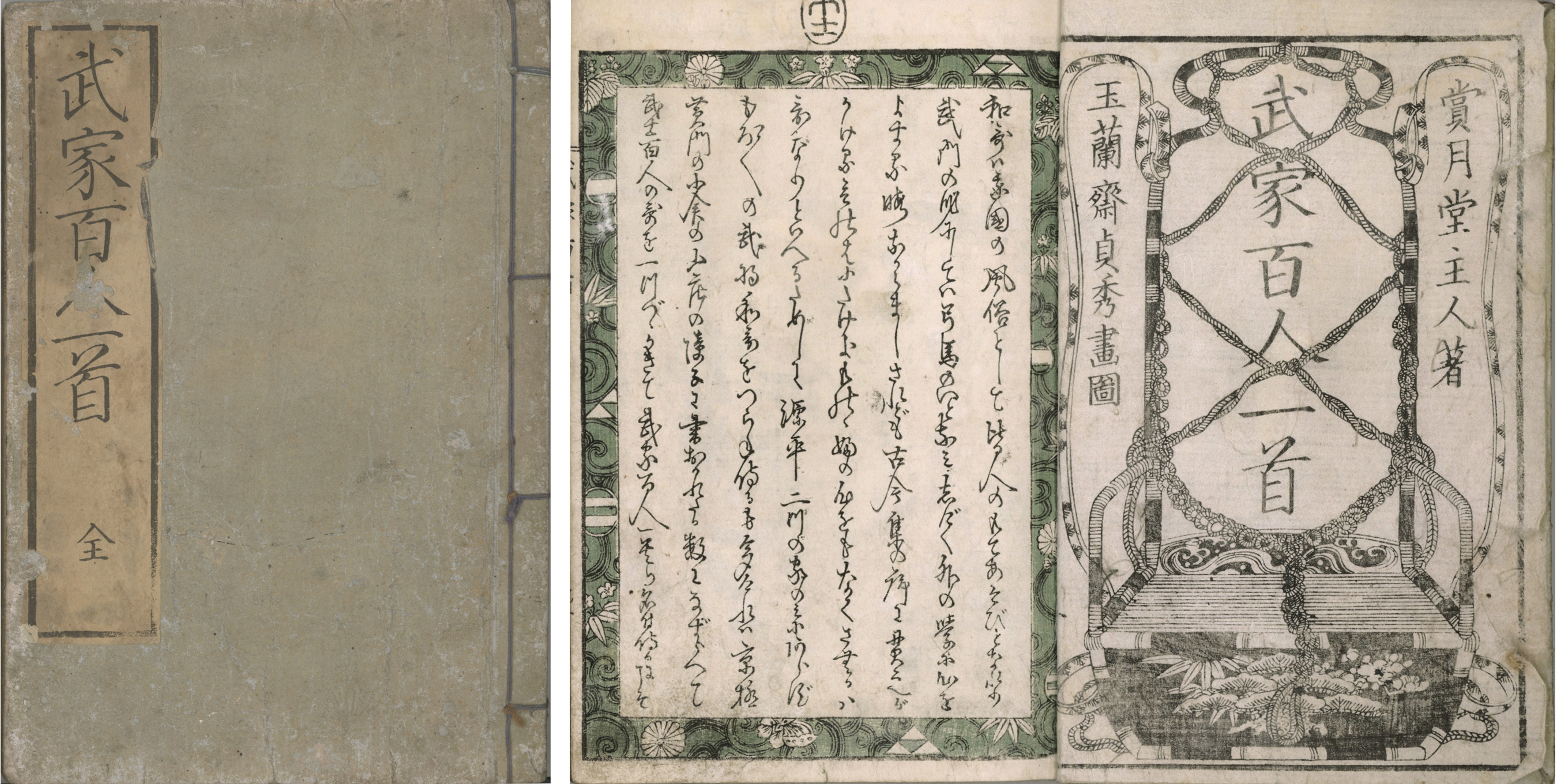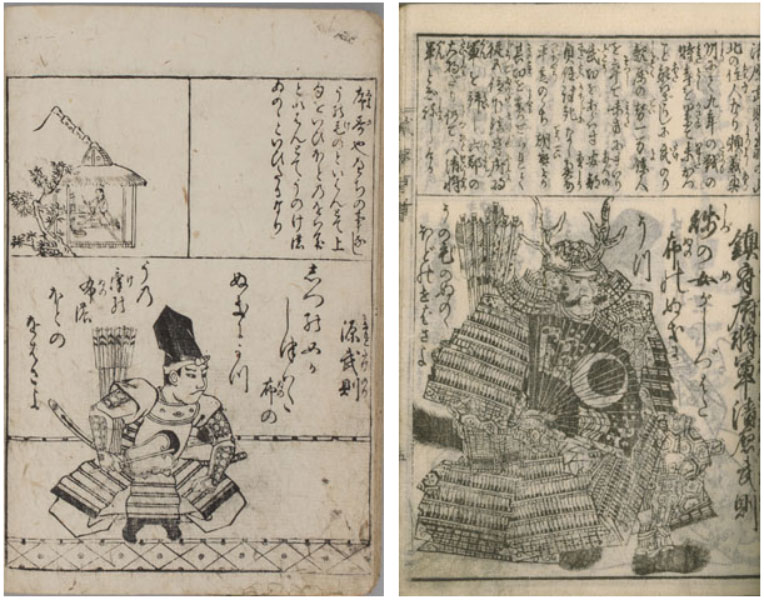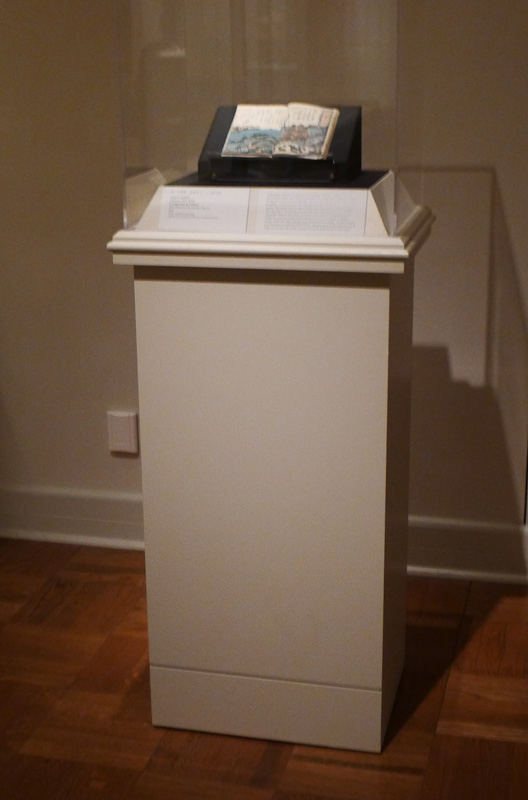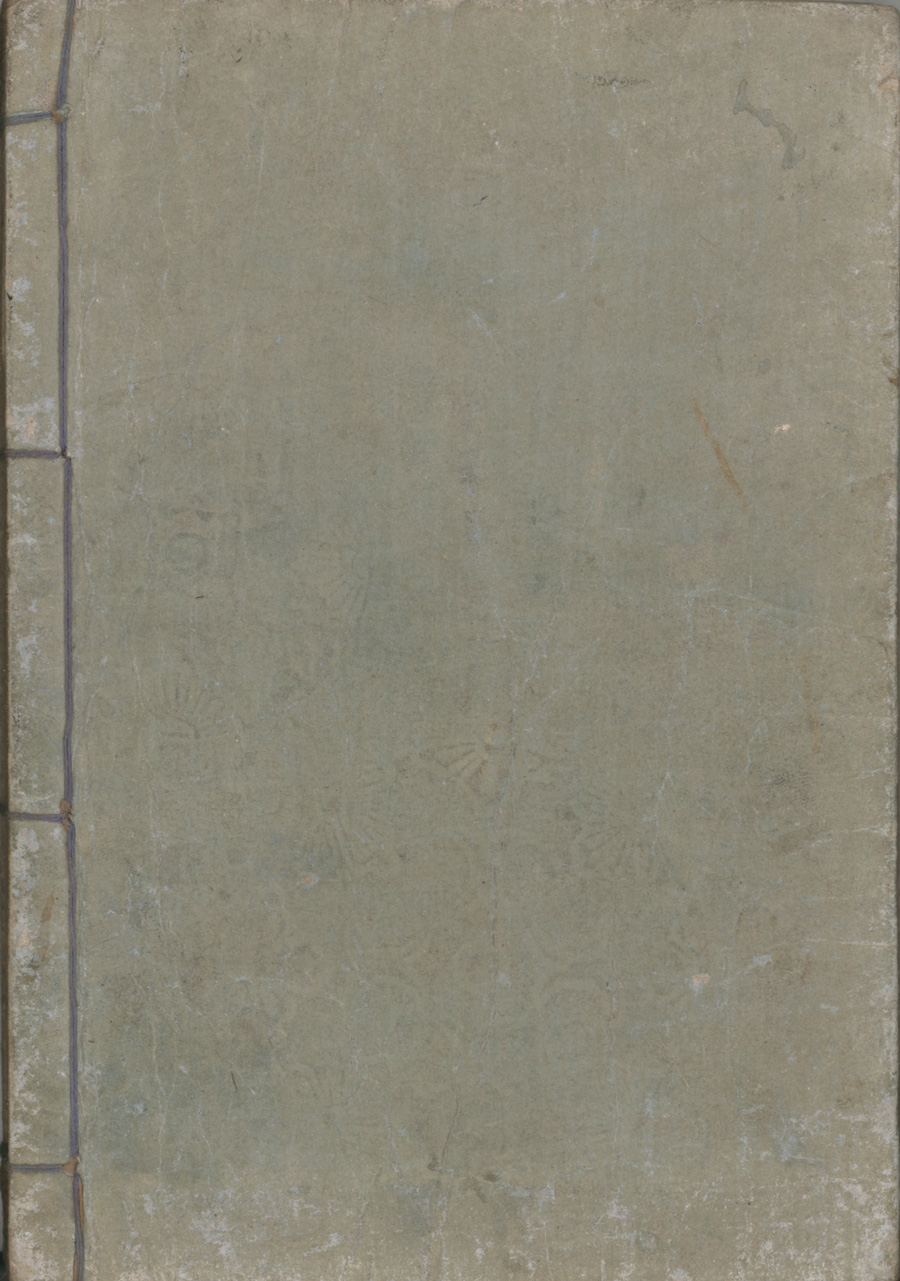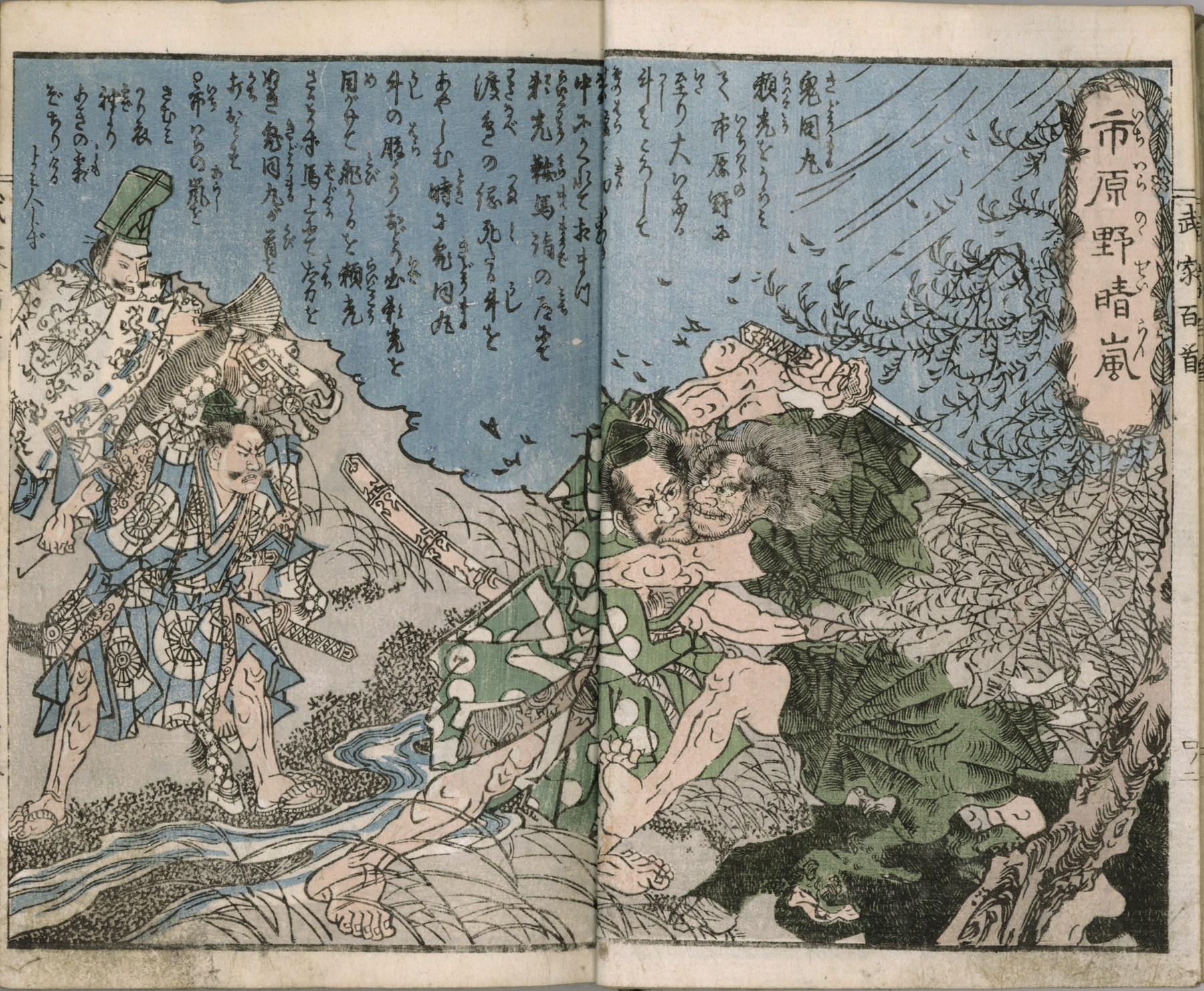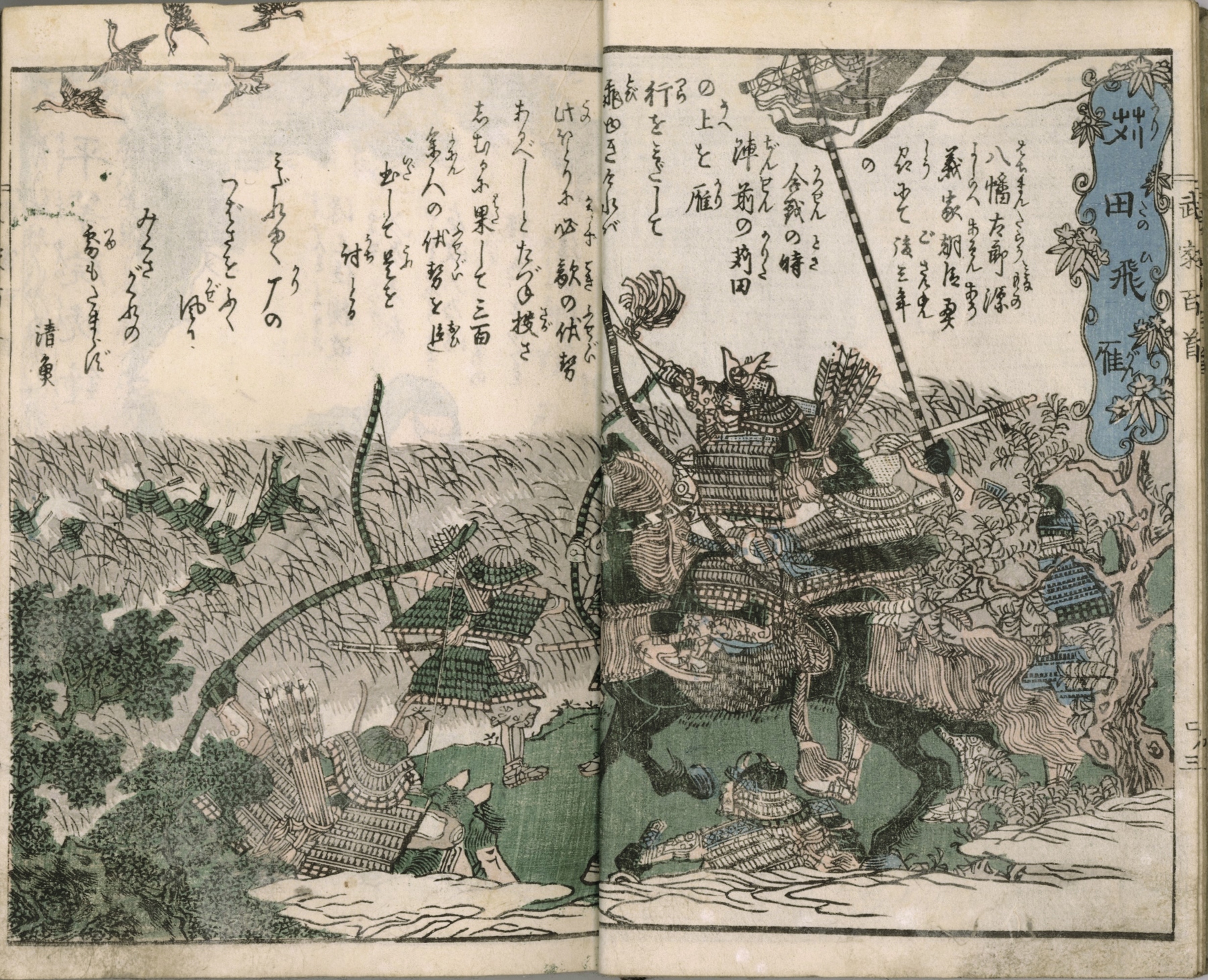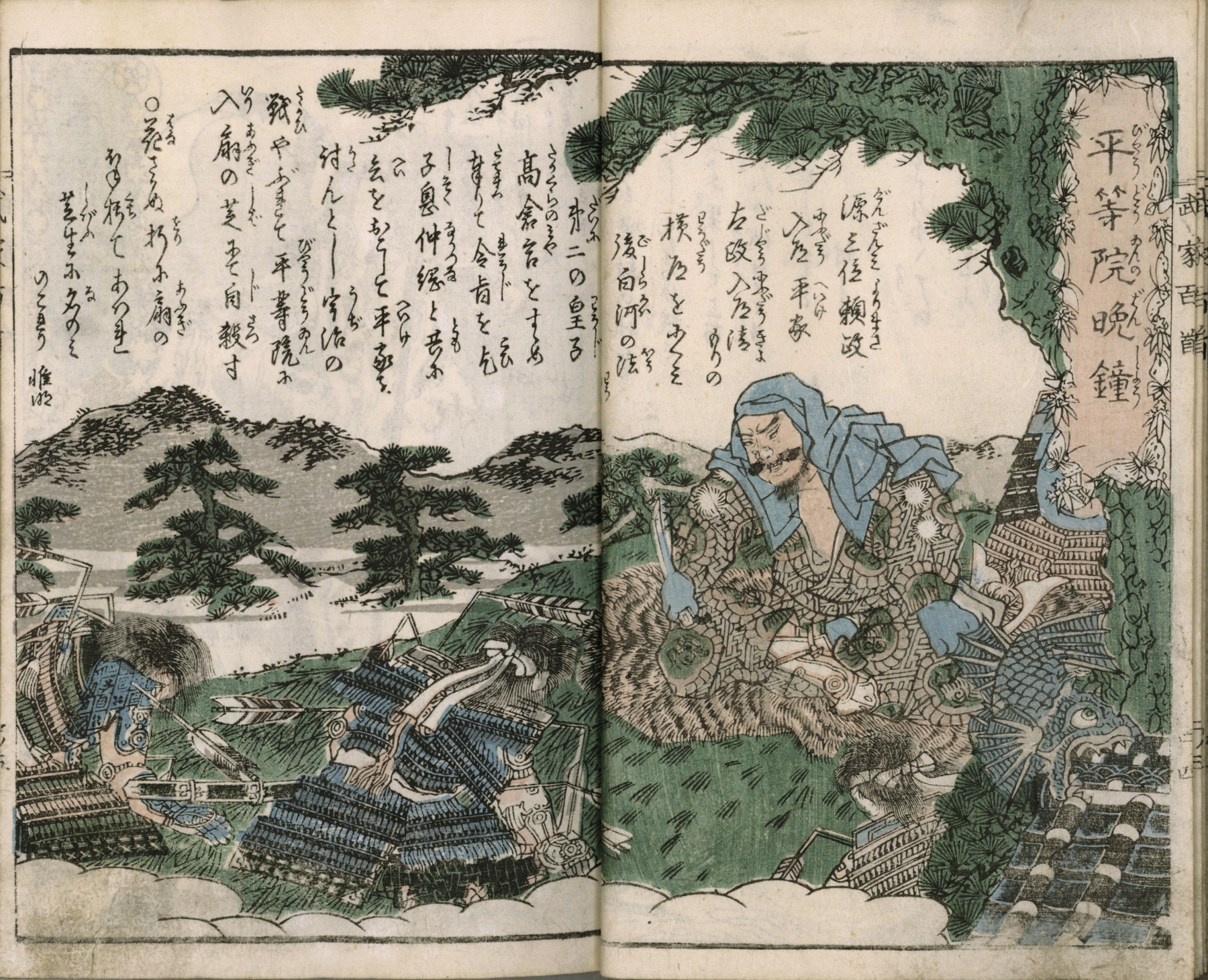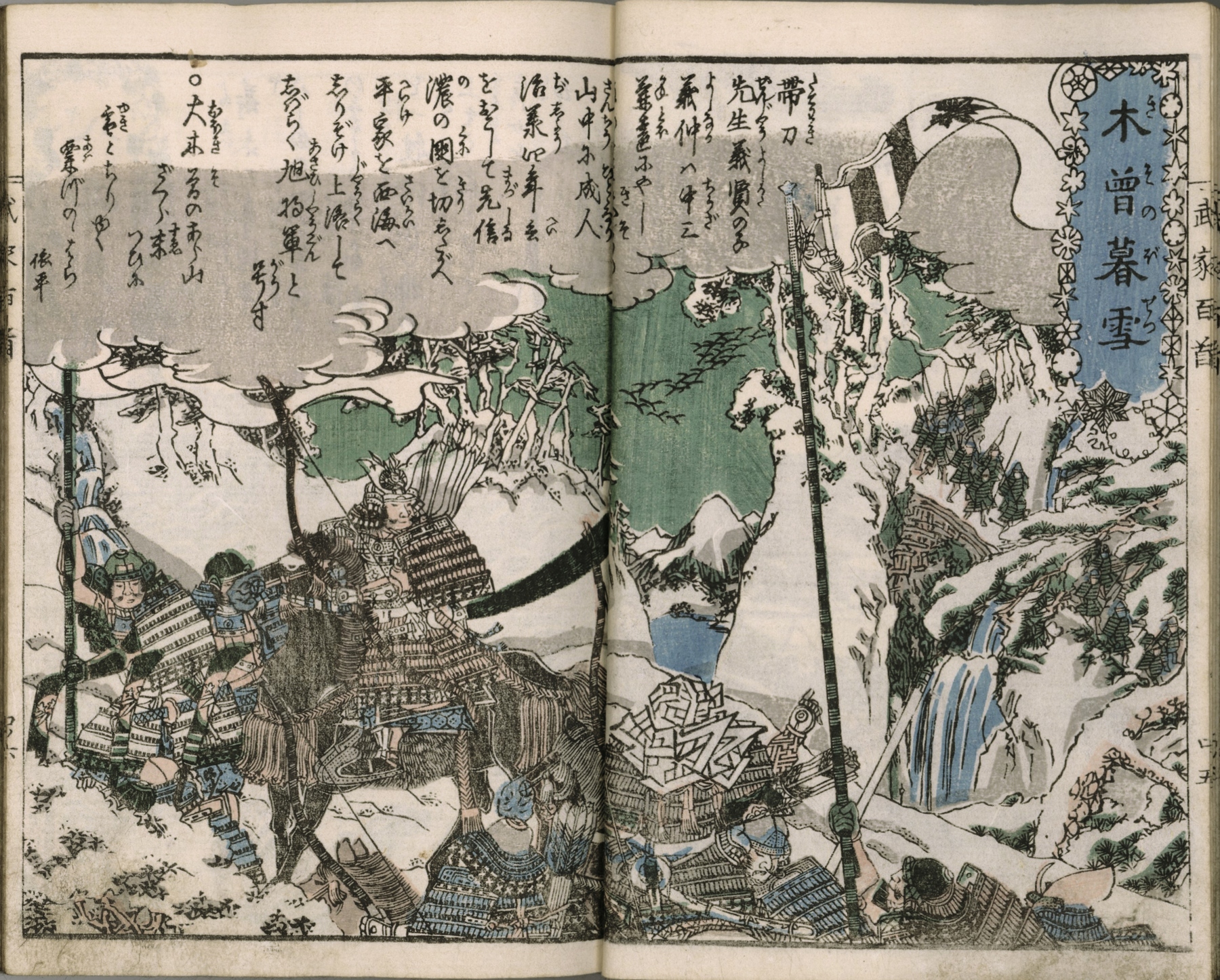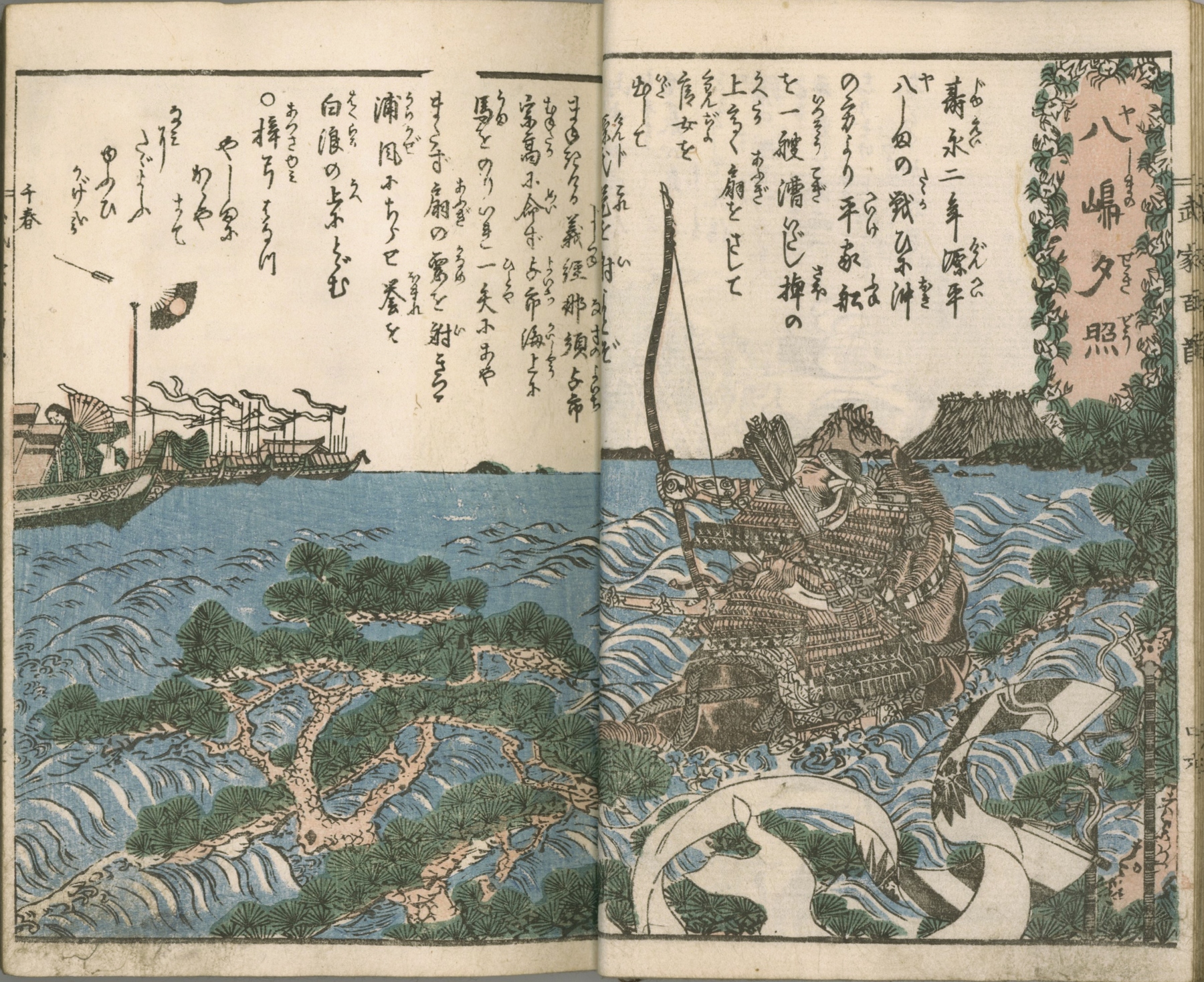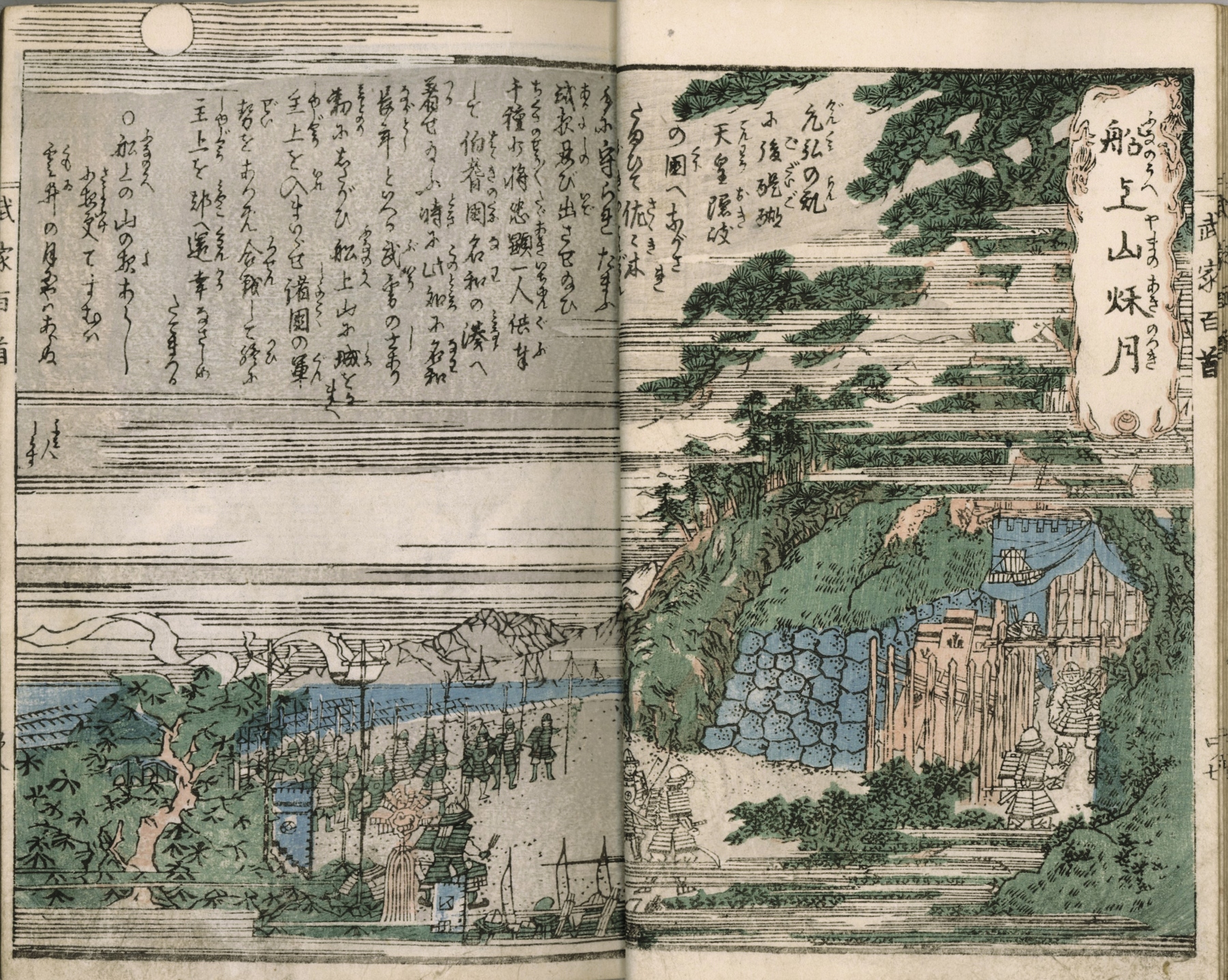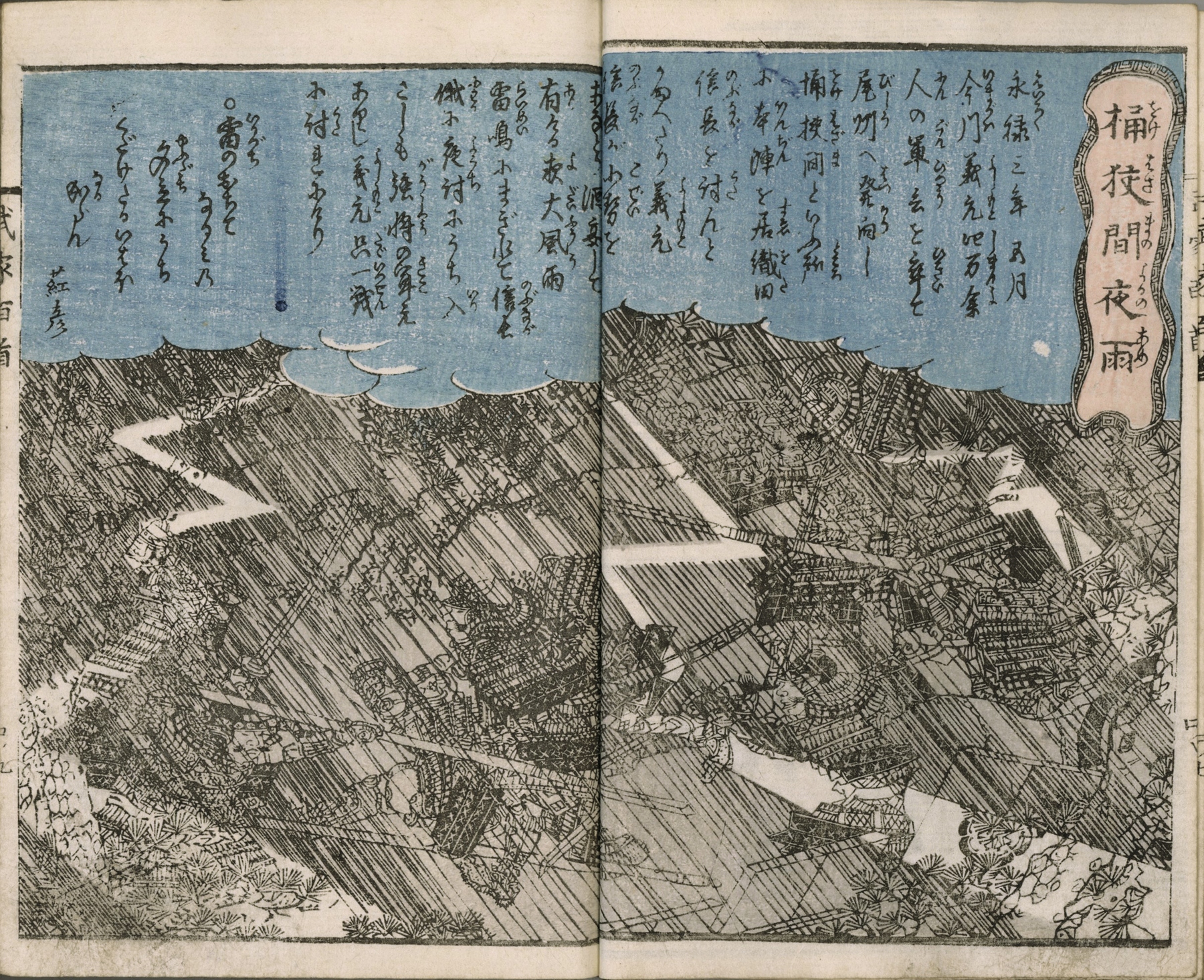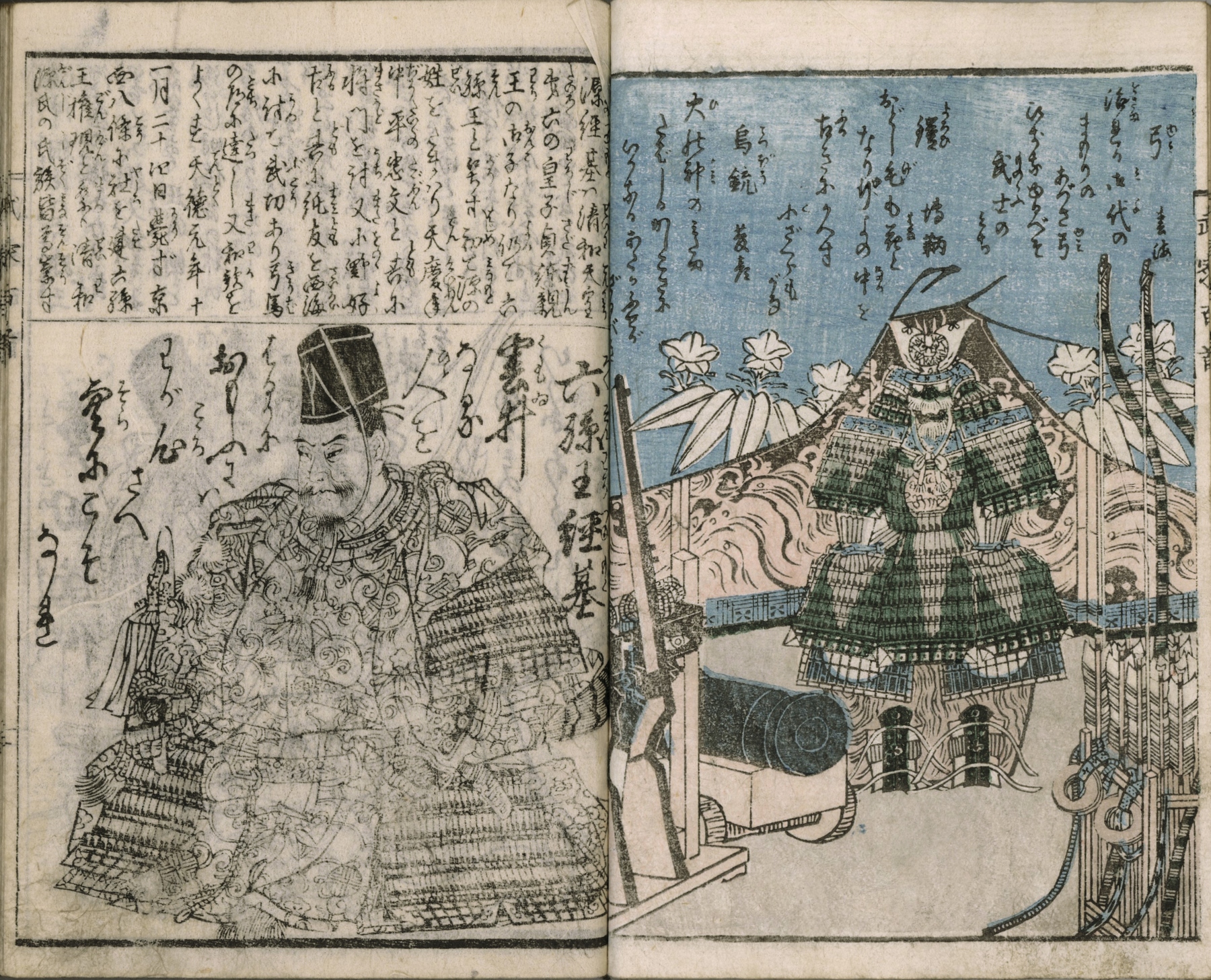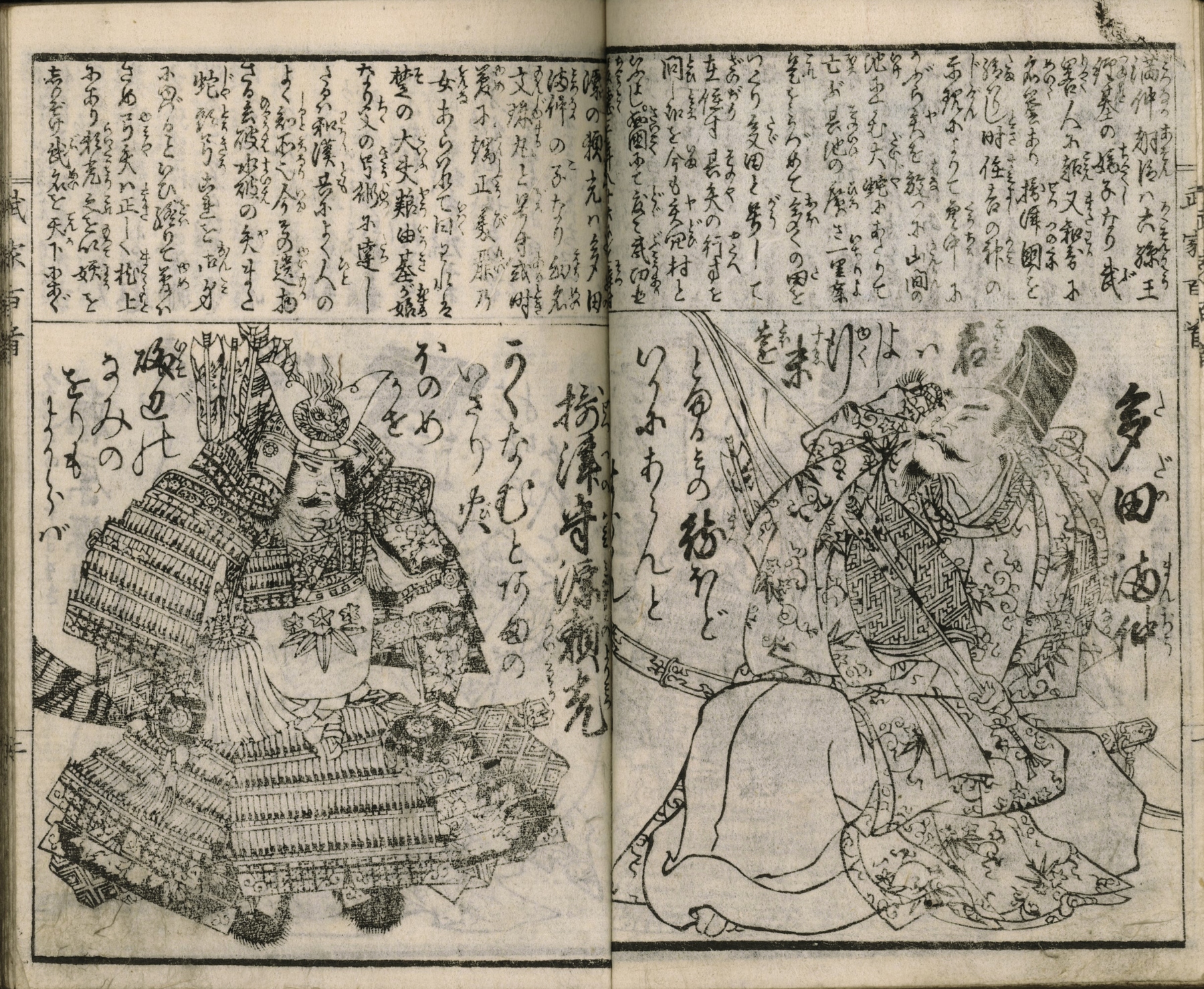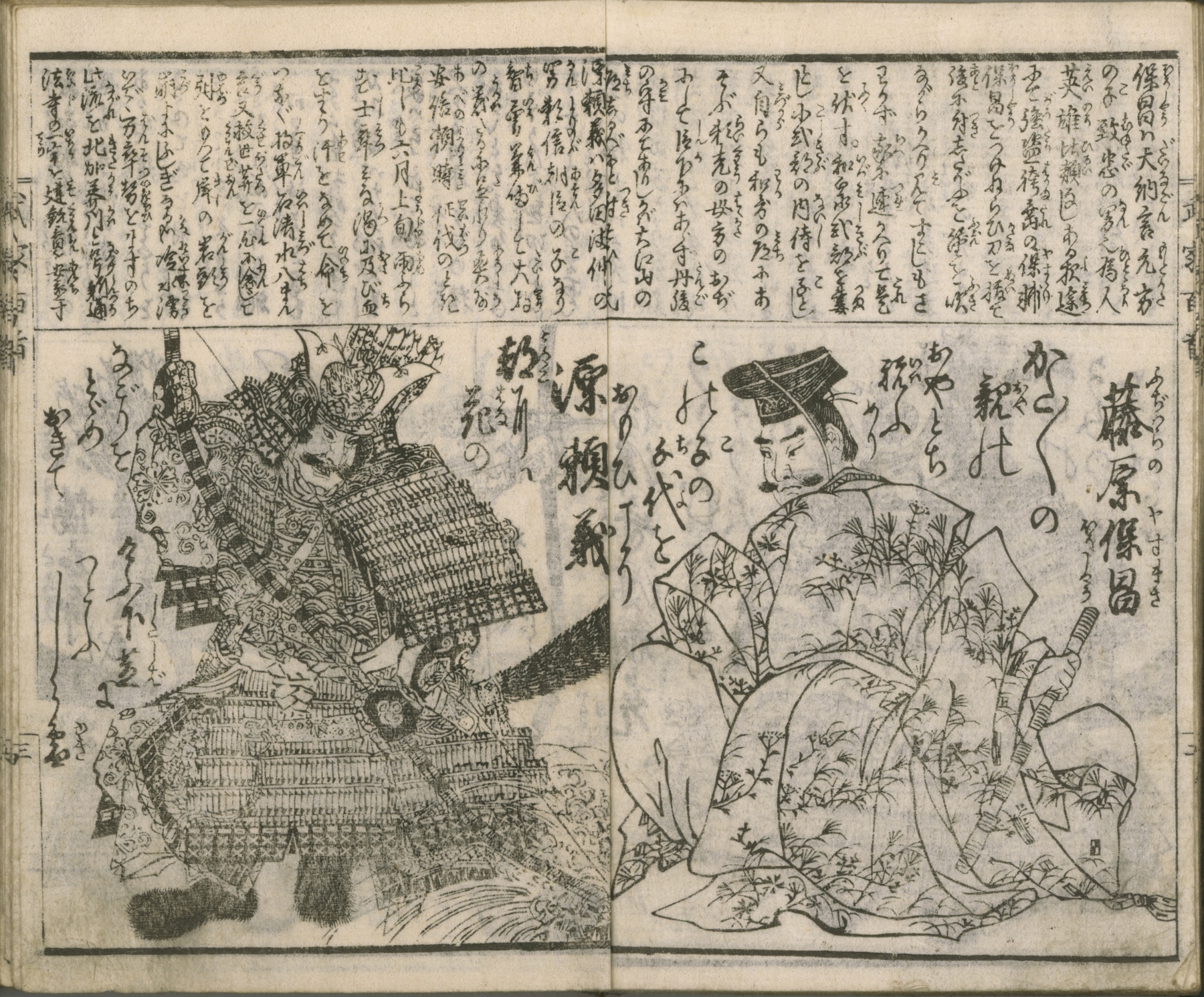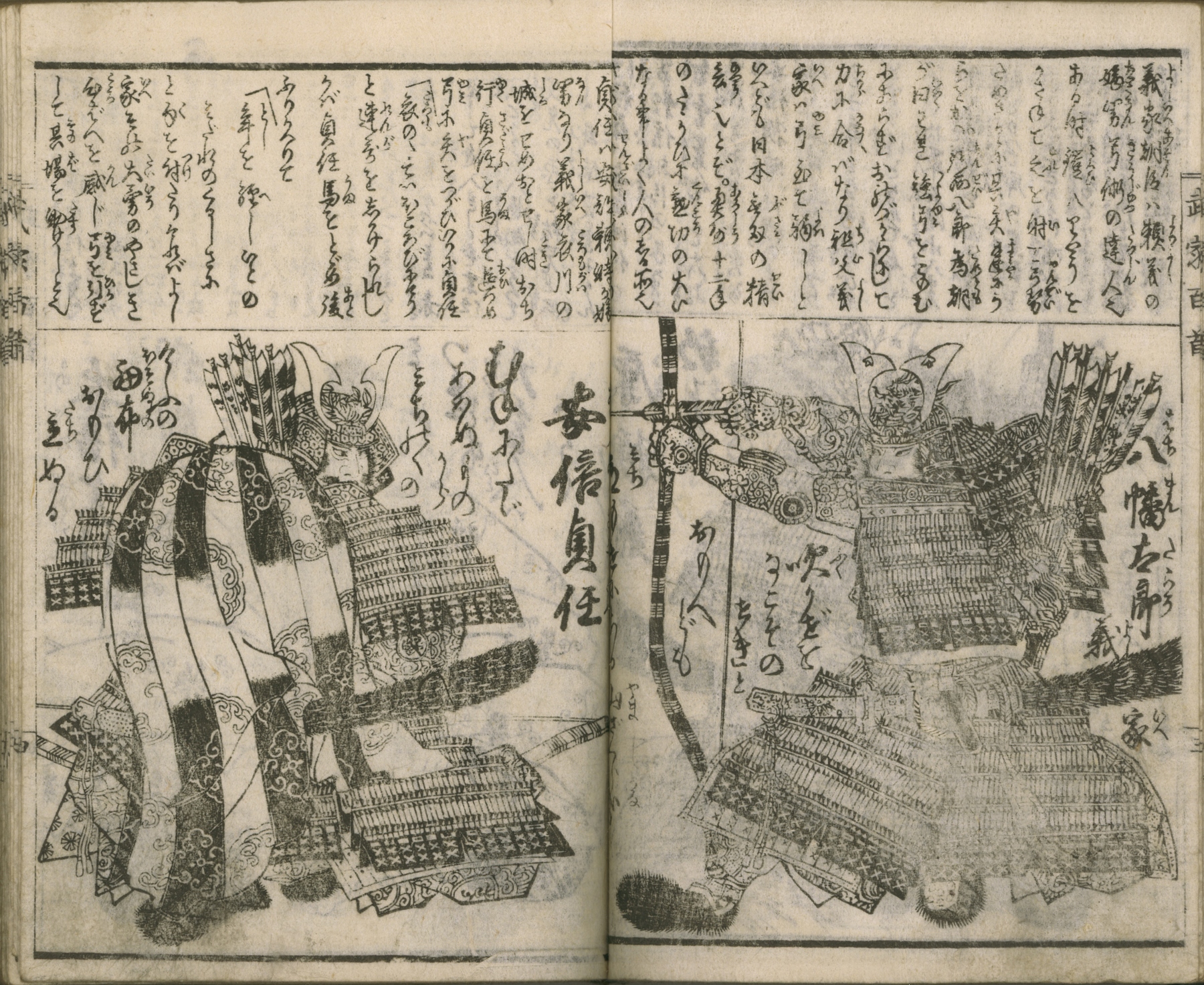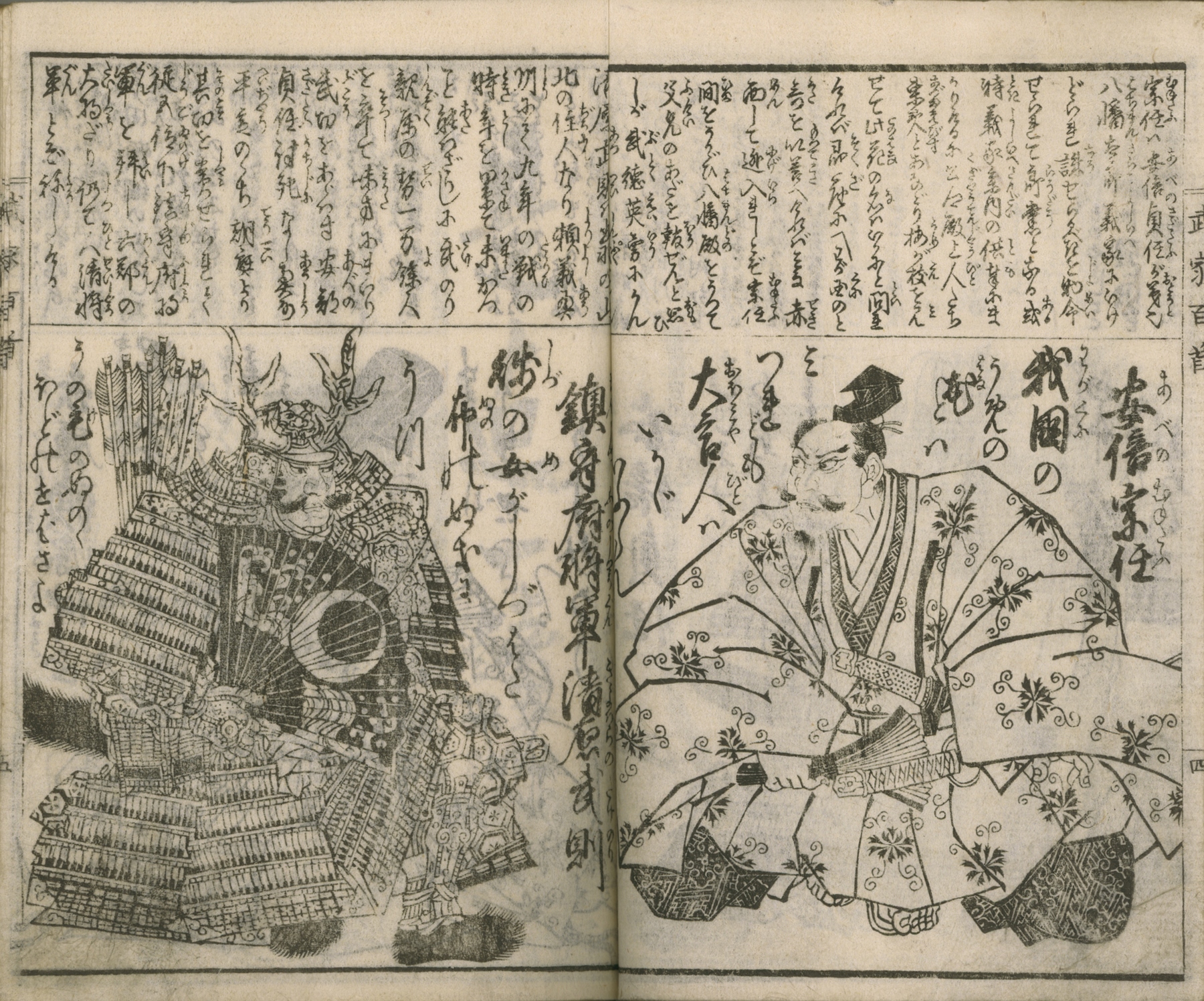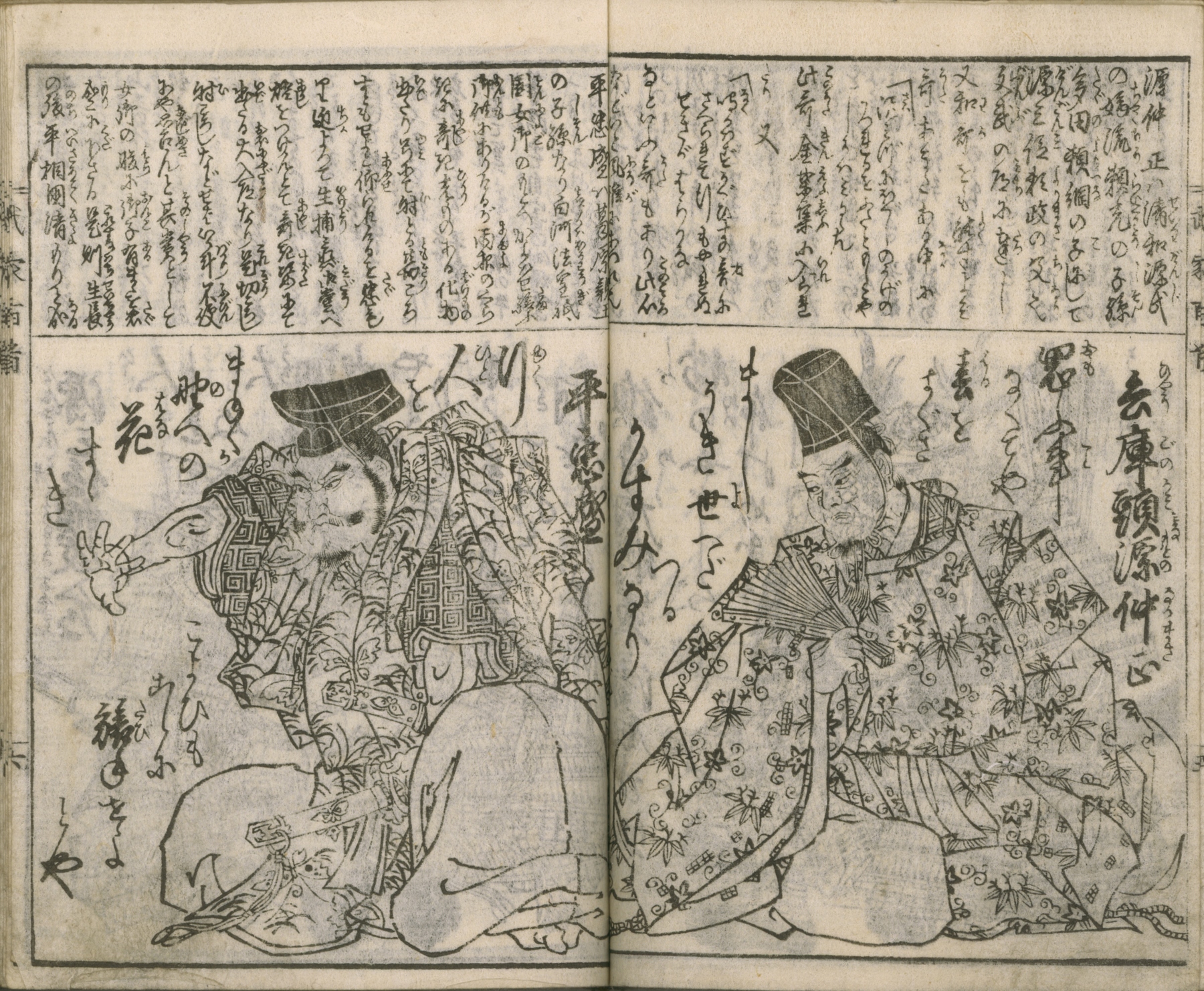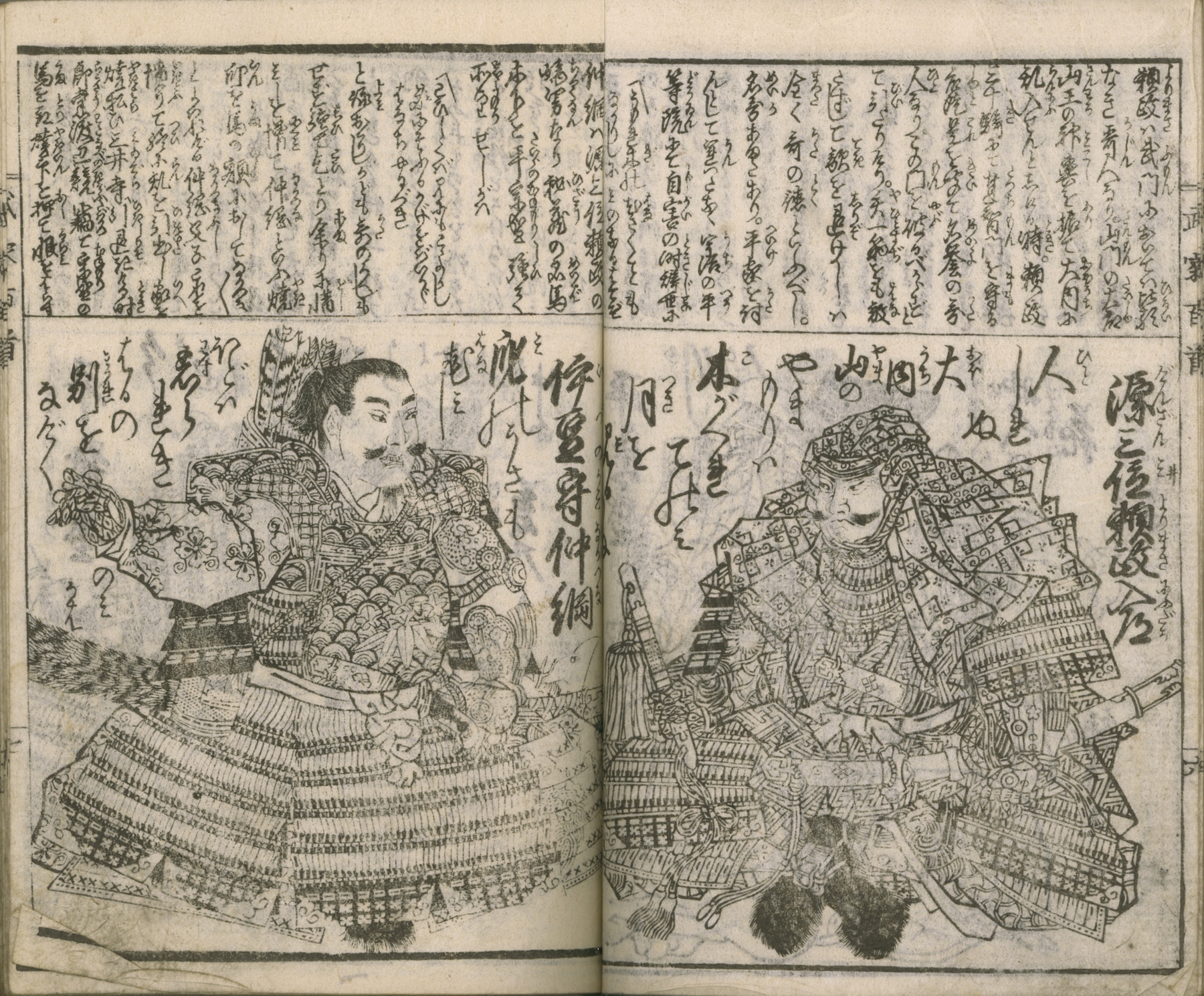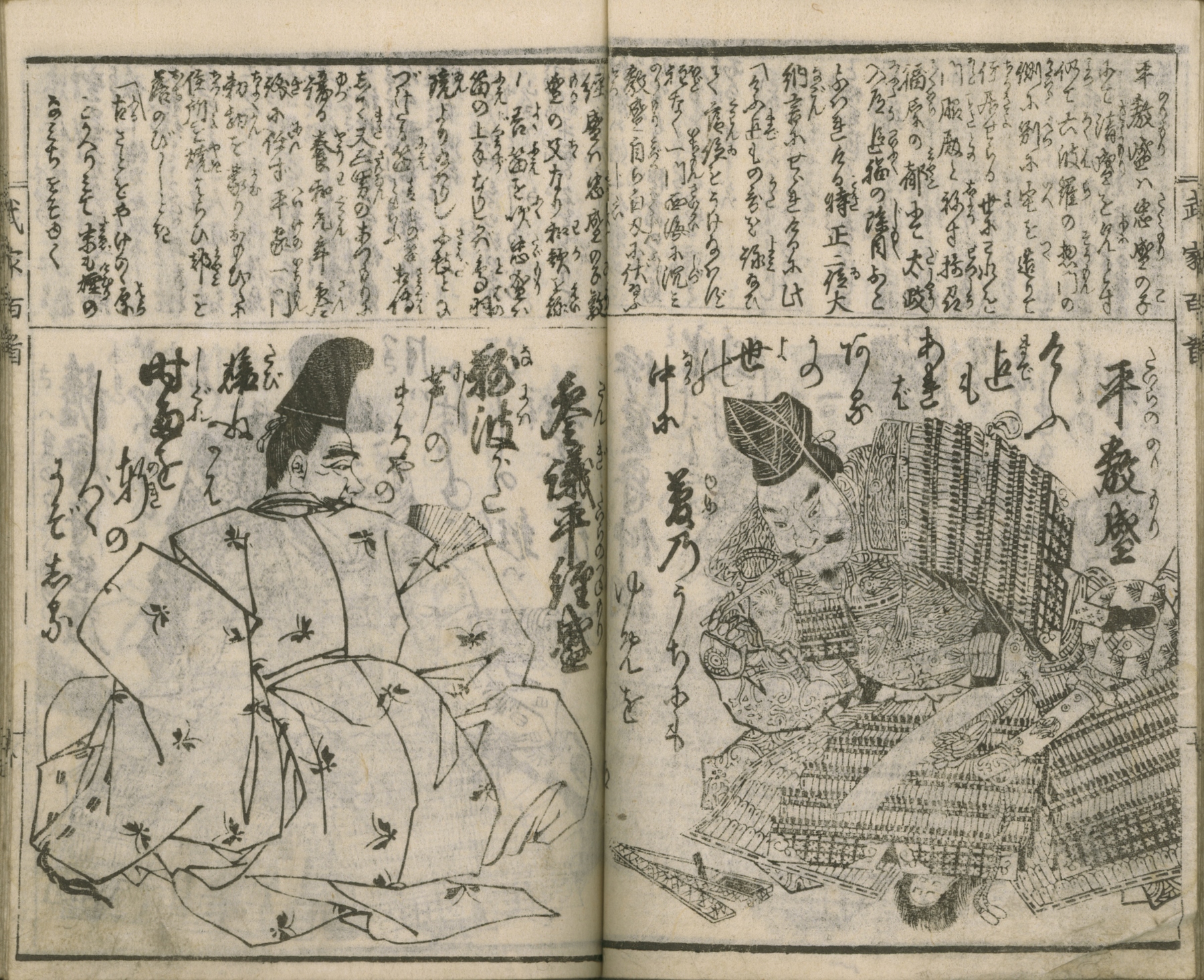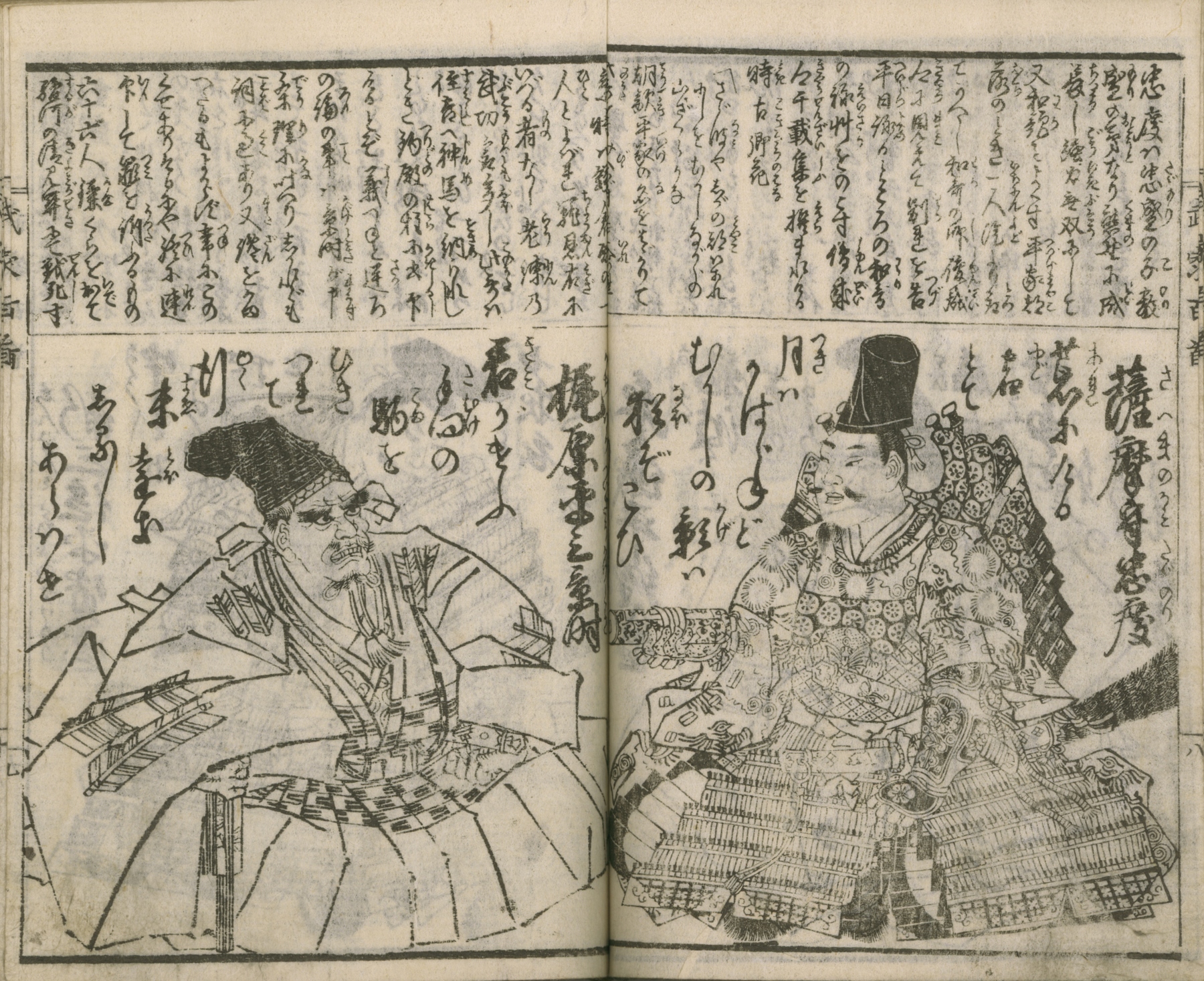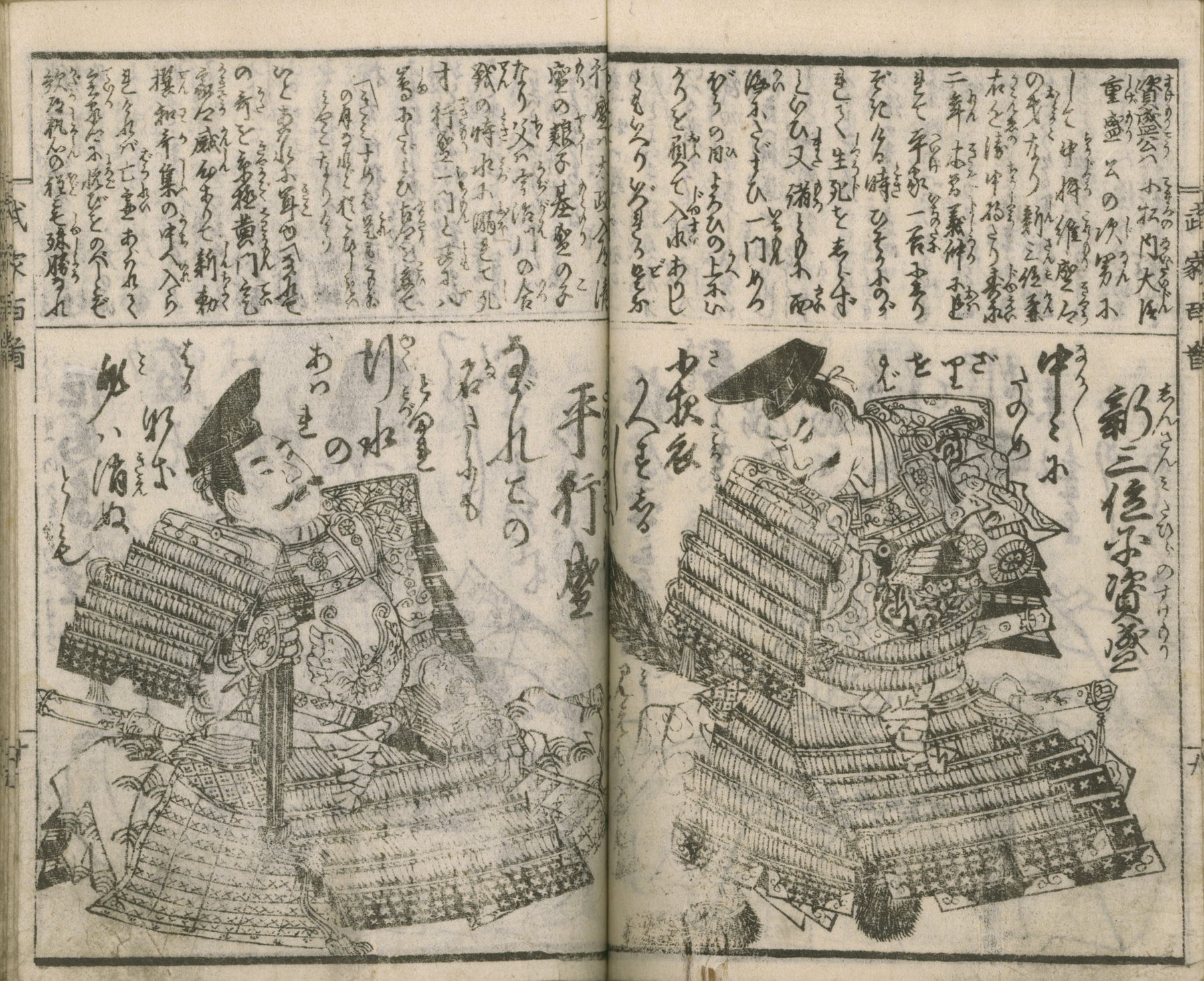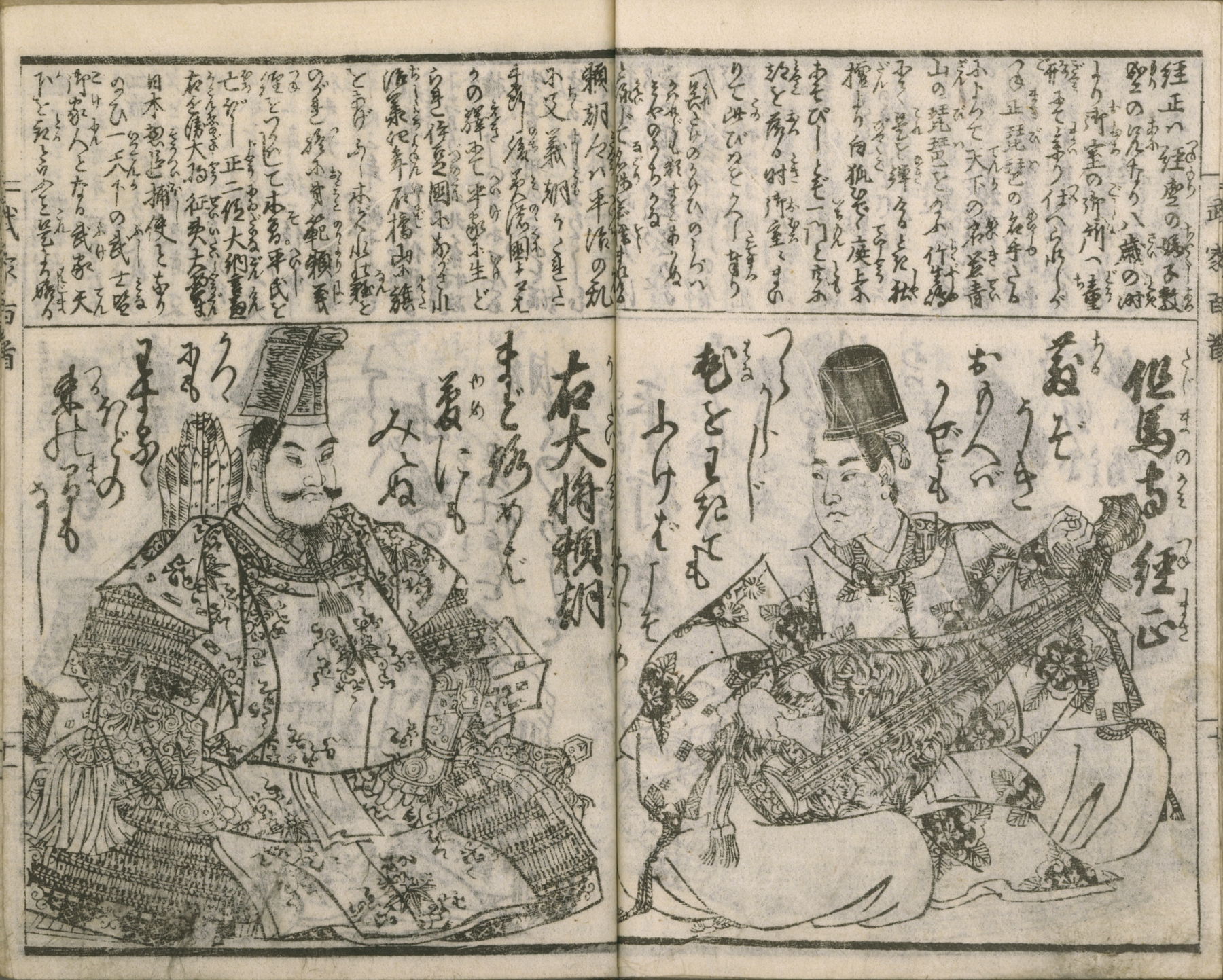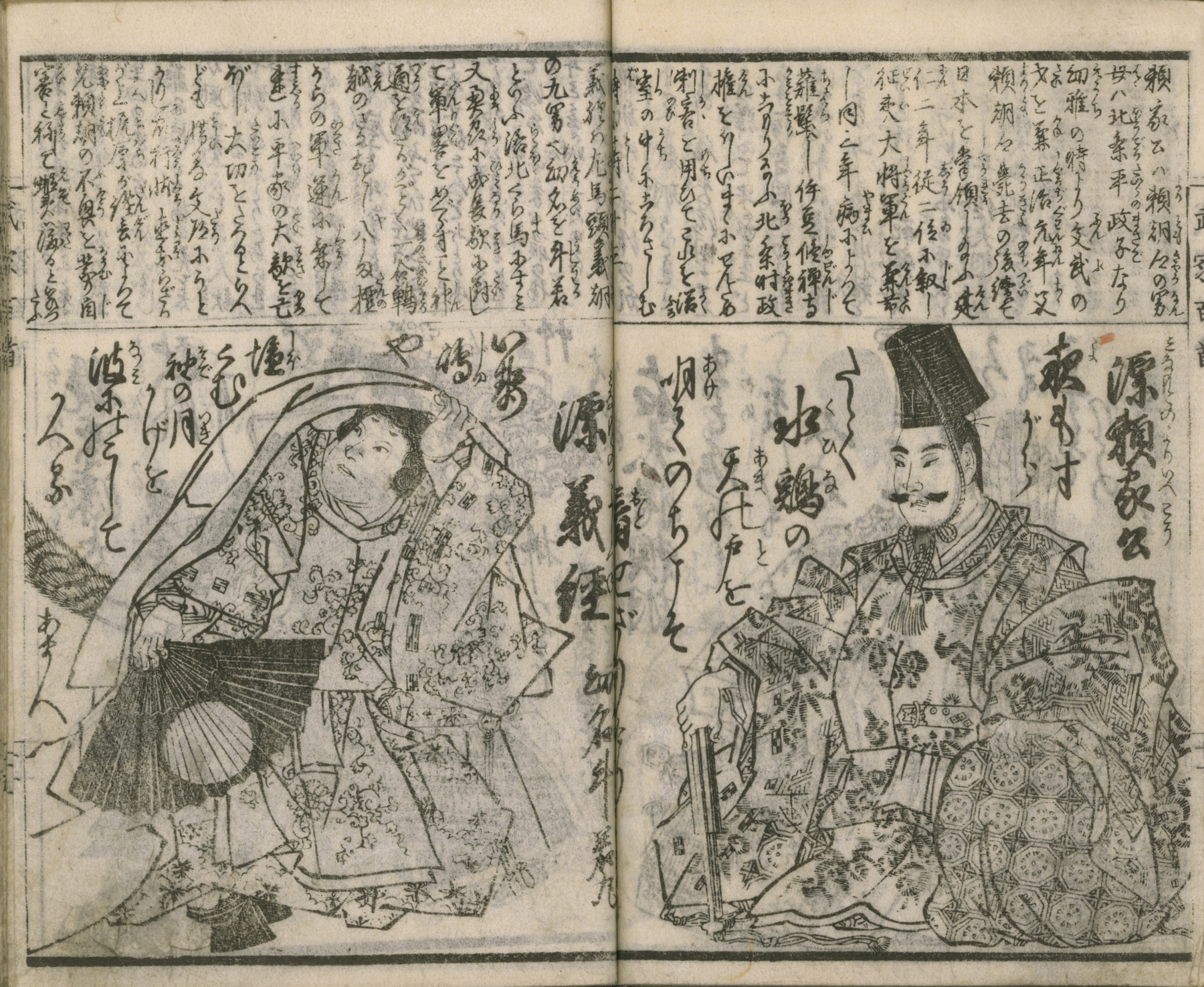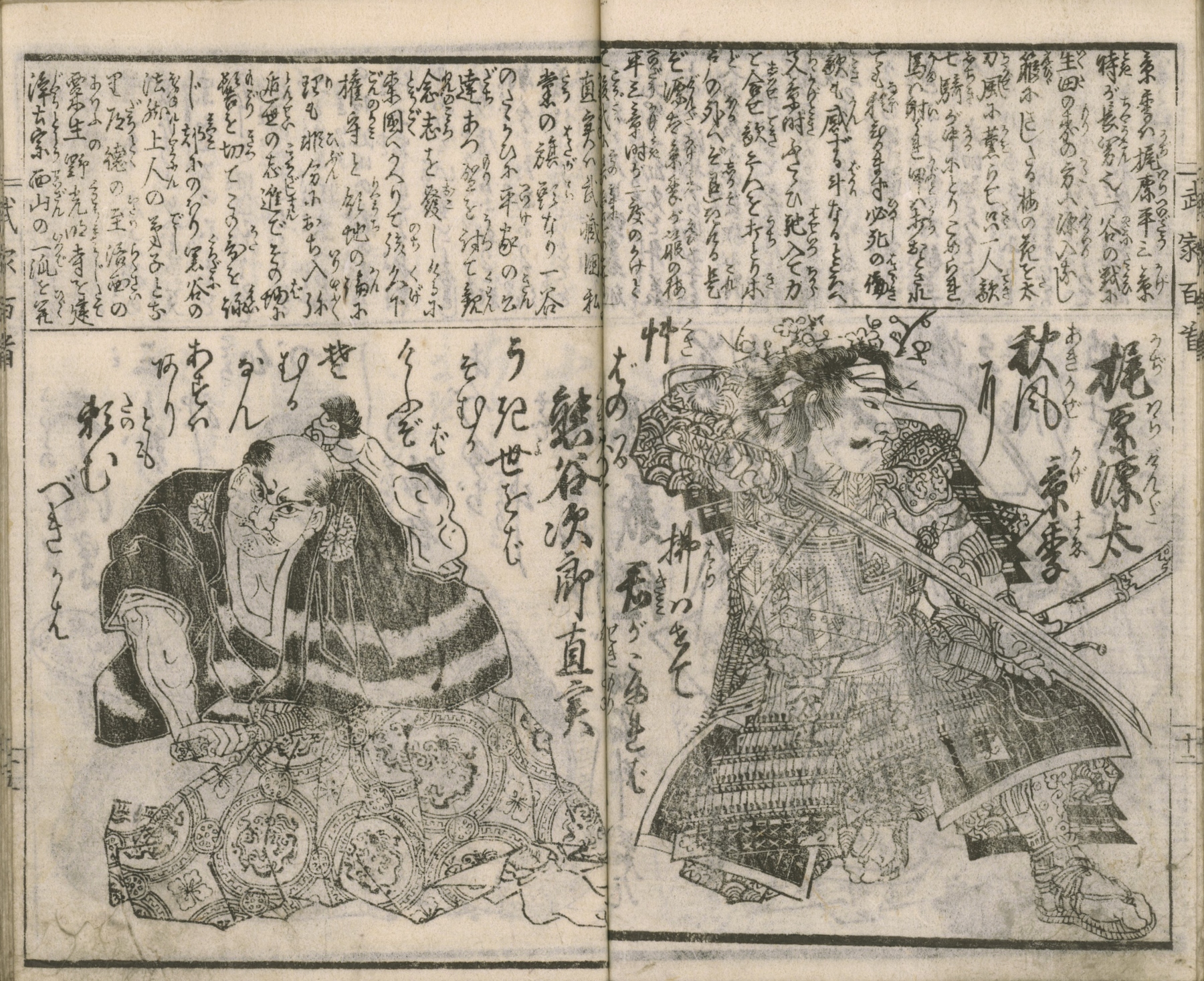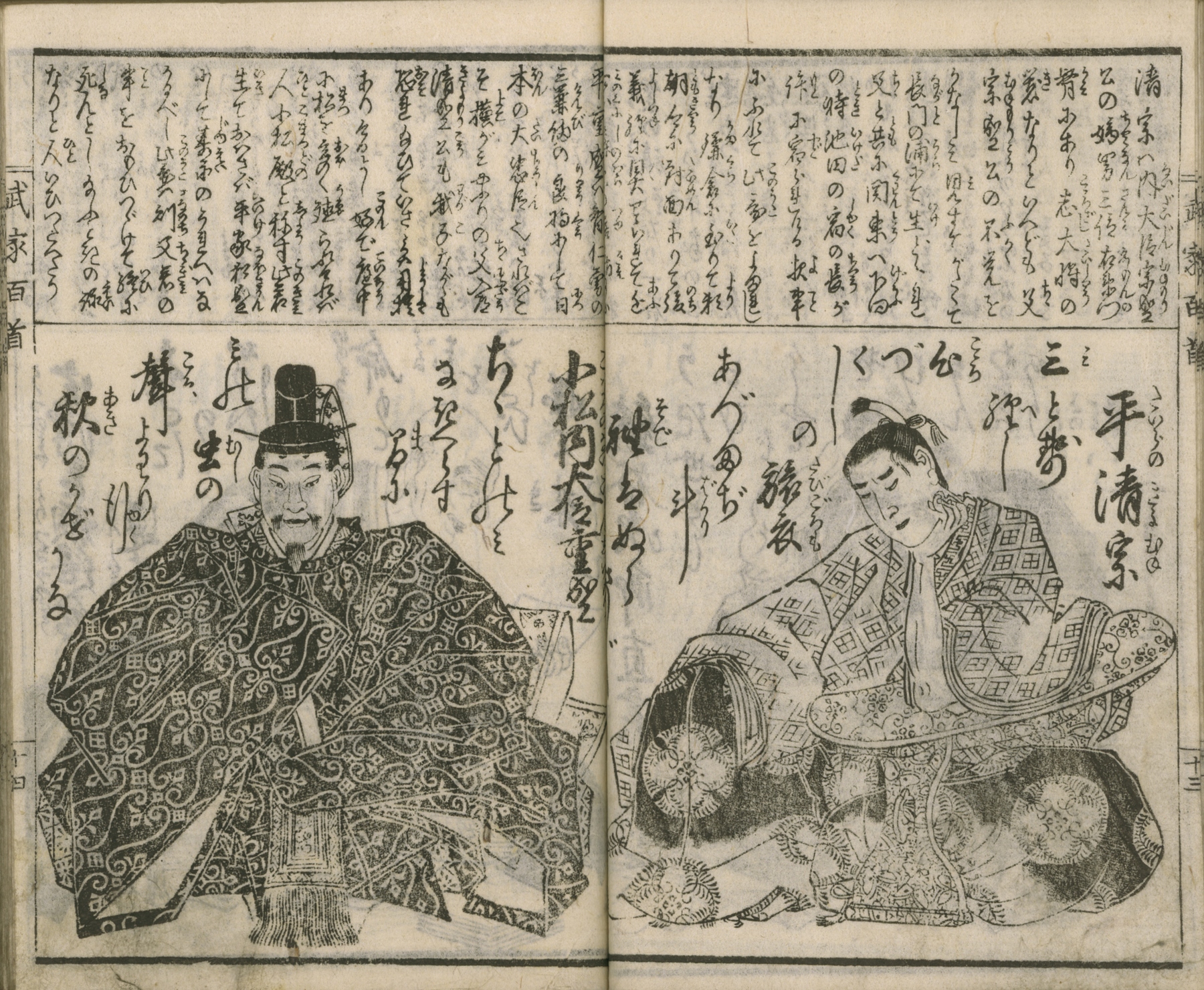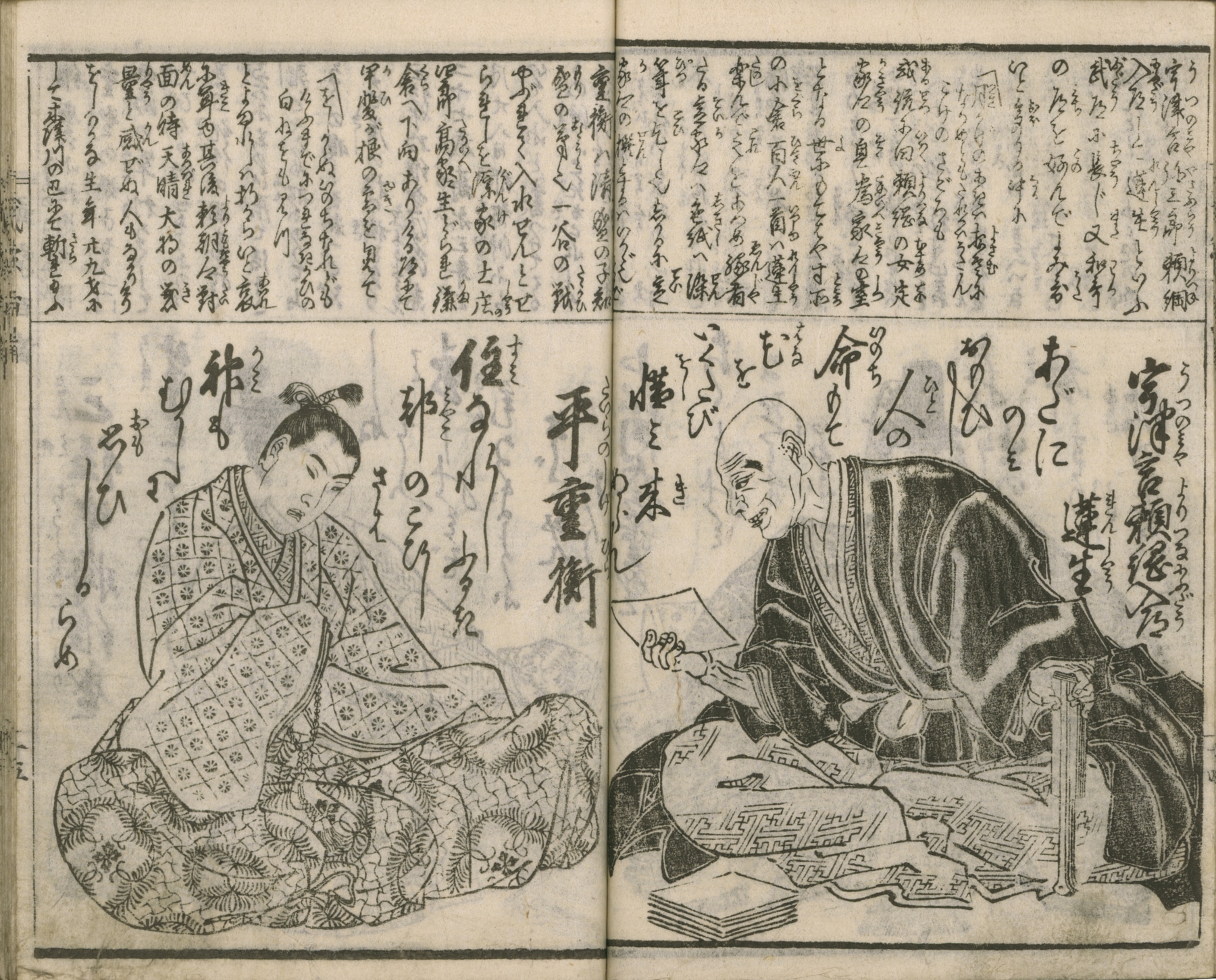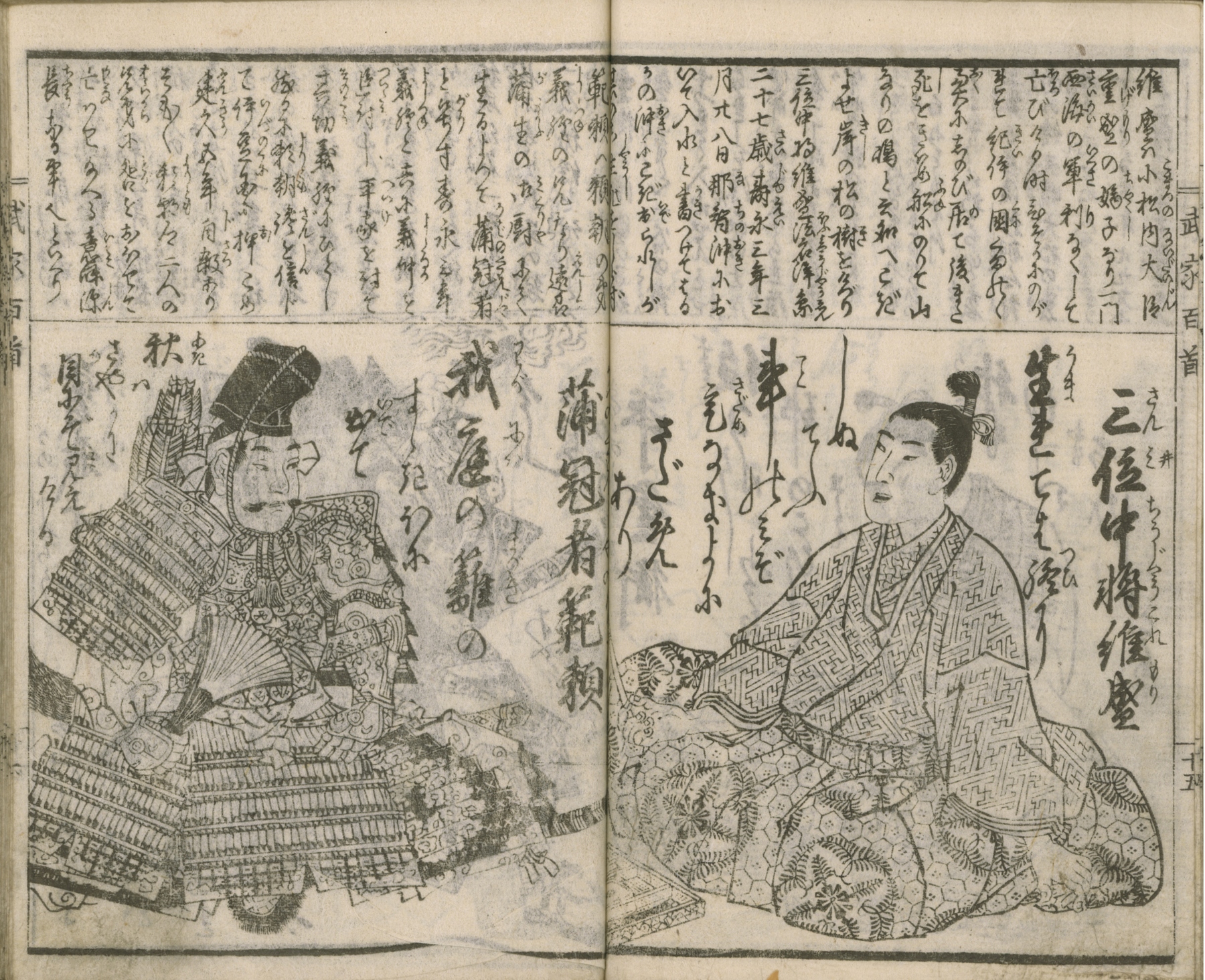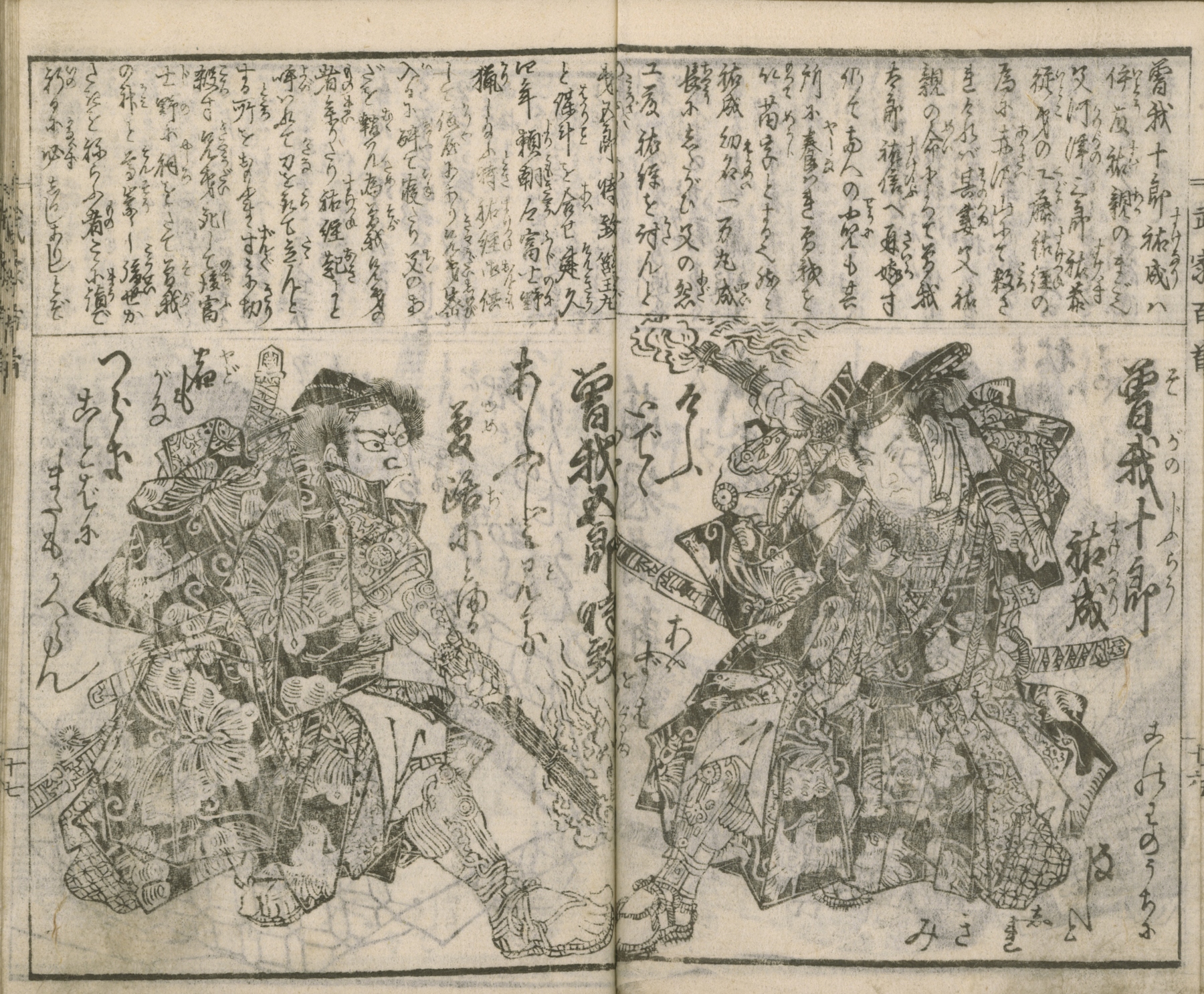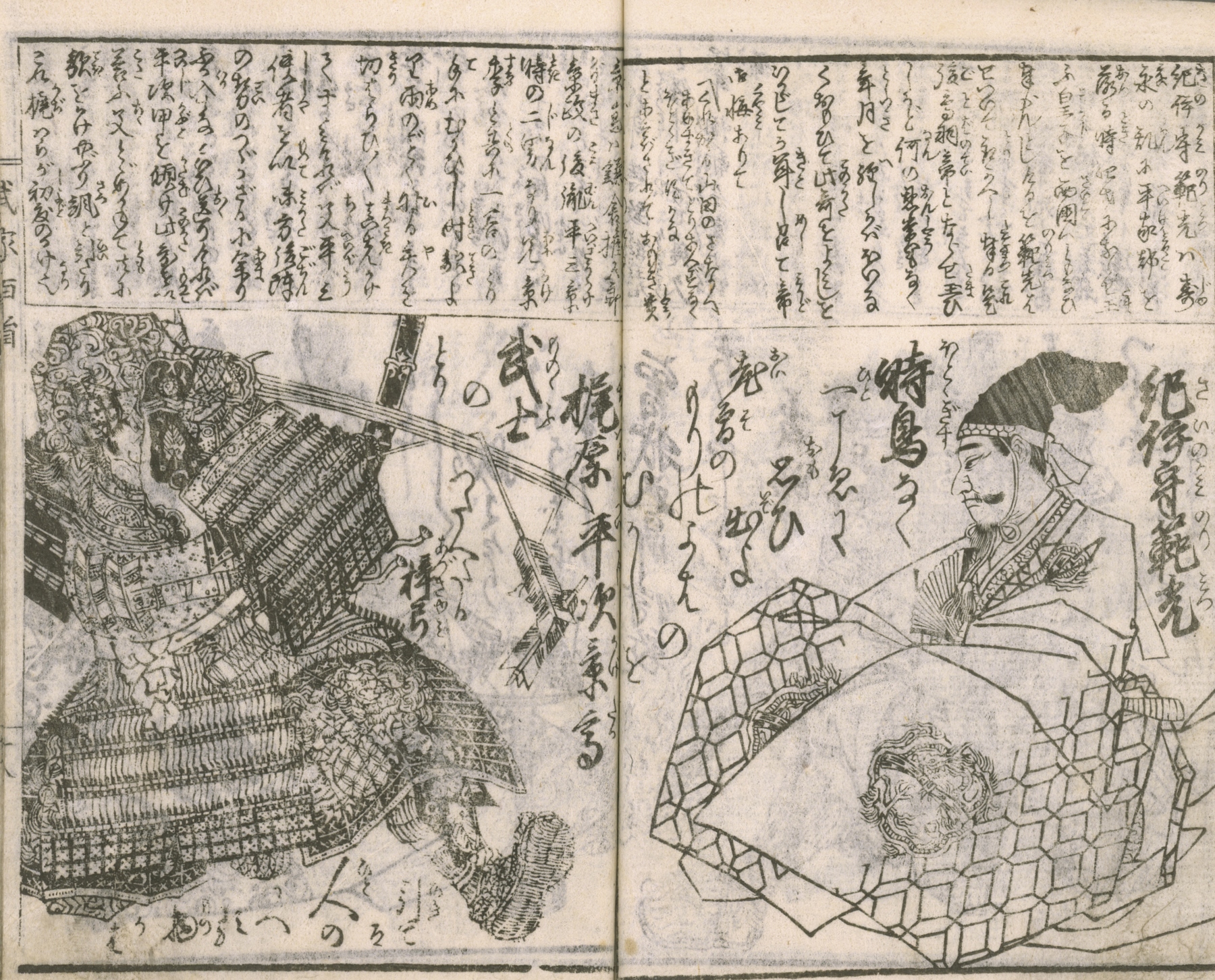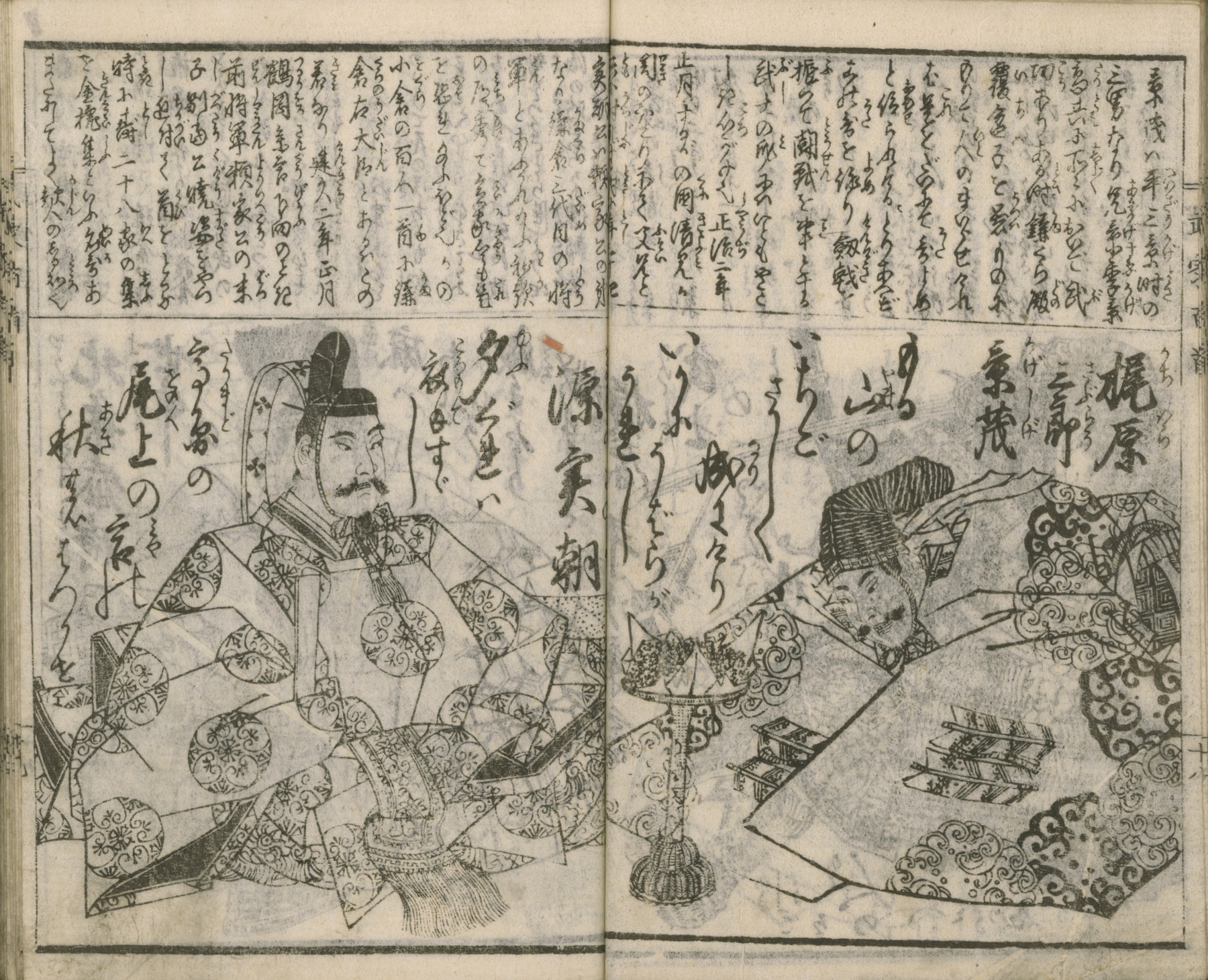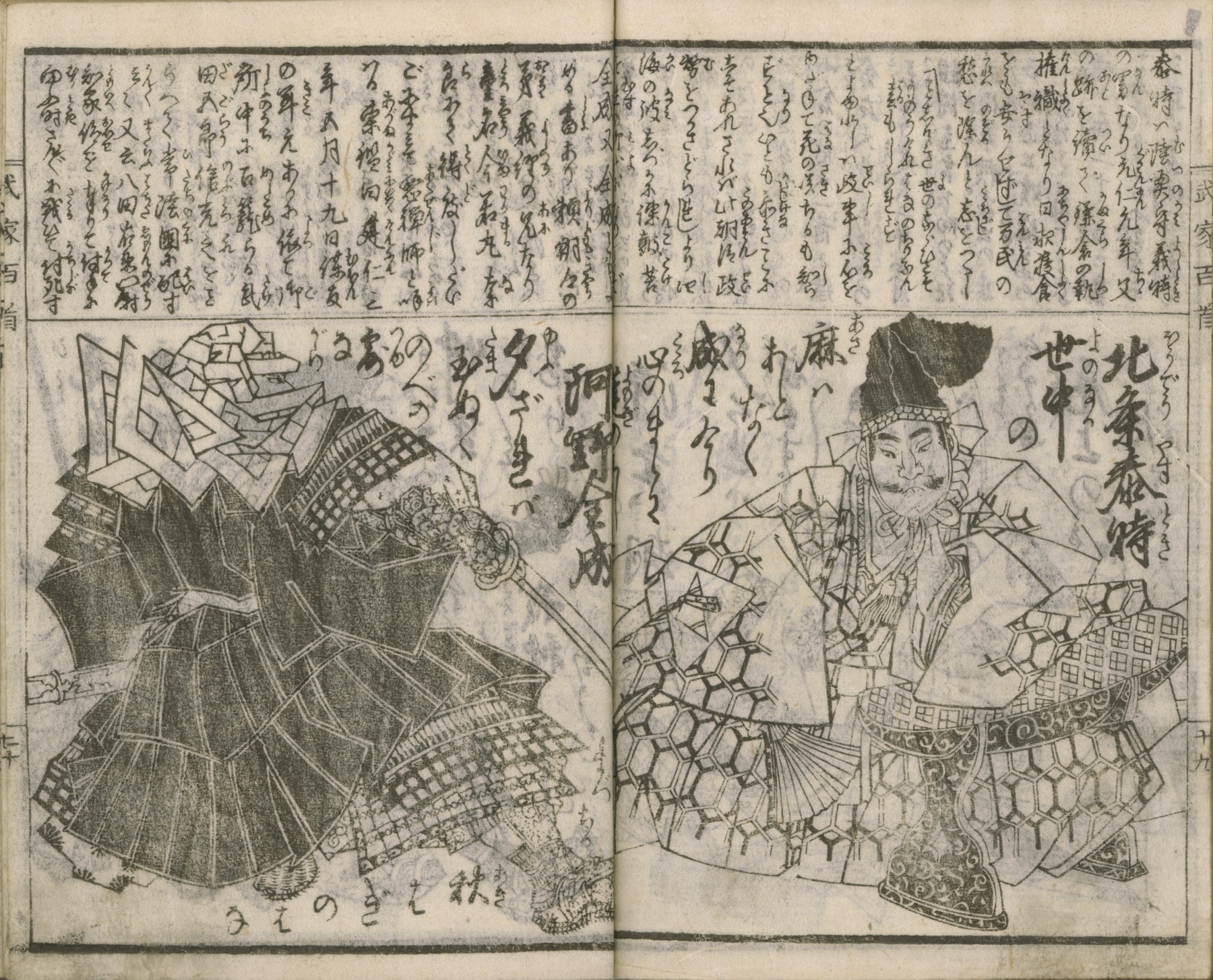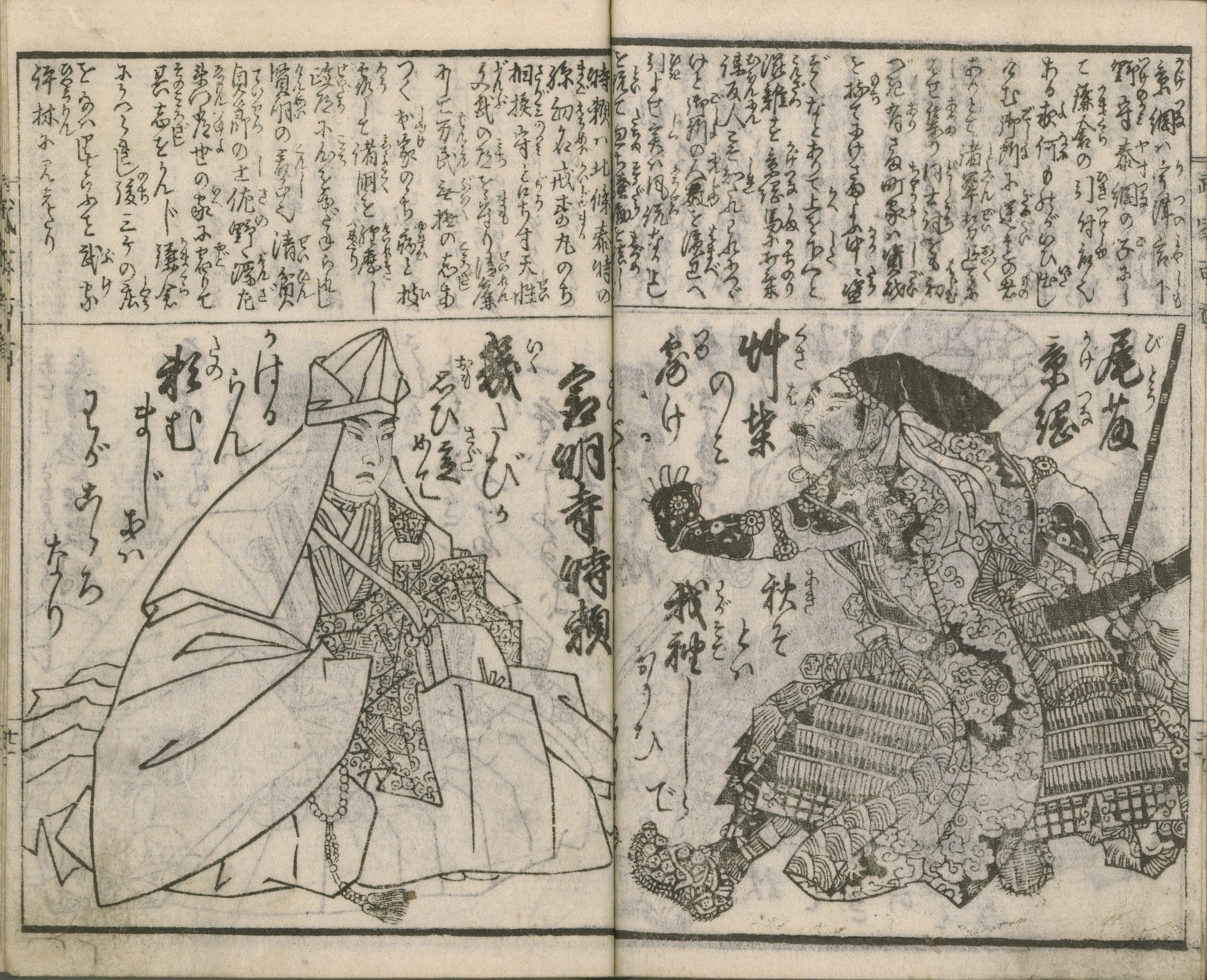An 1858 version of Buke hyakunin isshu ("One Hundred Warrior Poets") by the artist Utagawa Sadahide (1807-1873) and the writer Shōgetsudō Shujin (fl. 1856-1864). This 1858 version of Buke hyakunin isshu is prefaced with eight battle scenes (titled, Eight Scenes of Great Battles of Japan 本 朝戦場八景) each occupying a double page, all of which have taken the titles associated with the Chinese literary and artistic theme of "Eight Views."
Introduced to Japan in the fifteenth century, Eight Views (or hakkei in Japanese), was adaptedto various Japanese scenes and in the seventeenth century taken over by Ukiyo-e artists. The eight themes, "clearing weather", "evening glow", "returning sails", "night rain", "evening bells", "autumn moon", "descending geese" and "lingeringsnow", were fundamentally the same, regardless of locale.1
Buke Hyakunin isshu was originally issued in illustrated form in 1672 by the publisher Tsuruya Kiemon, with illustrations by the artist Hishikawa Moronobu (1618-1694). By signing his name to the 1672 Buke Hyakunin isshu, Moronobu "became the first ukiyo-e artist to affix his name to a printed work."2 It should be noted that Buke Hyakunin isshu is not a version of very popular Hyakunin isshu (One Hundred Poets), issued six years later in illustrated form and also bearing Moronobu's name, "but an independent work bringing together one hundred poems by one hundred famous samurai," targeted at Edo's samurai class.3 Buke hyakunin isshu "linked the warrior class to cultural pursuits and refinements."4
Introduced to Japan in the fifteenth century, Eight Views (or hakkei in Japanese), was adaptedto various Japanese scenes and in the seventeenth century taken over by Ukiyo-e artists. The eight themes, "clearing weather", "evening glow", "returning sails", "night rain", "evening bells", "autumn moon", "descending geese" and "lingeringsnow", were fundamentally the same, regardless of locale.1
Buke Hyakunin isshu was originally issued in illustrated form in 1672 by the publisher Tsuruya Kiemon, with illustrations by the artist Hishikawa Moronobu (1618-1694). By signing his name to the 1672 Buke Hyakunin isshu, Moronobu "became the first ukiyo-e artist to affix his name to a printed work."2 It should be noted that Buke Hyakunin isshu is not a version of very popular Hyakunin isshu (One Hundred Poets), issued six years later in illustrated form and also bearing Moronobu's name, "but an independent work bringing together one hundred poems by one hundred famous samurai," targeted at Edo's samurai class.3 Buke hyakunin isshu "linked the warrior class to cultural pursuits and refinements."4
Joshua Mostow notes that the technique of 'setting out the heart of poems in pictures' (uta no kokoro wo e ni shirusu) used in versions of Hyakunin isshu is also seen in the Buke hyakunin isshu.5
A quick comparison between the Moronobu 1672 illustrated version of Buke and this collection's Sadahide 1858 illustrated version shows that the 100 warriors pictured are not identical, although some of the same warrior poets are portrayed, as shown below in a comparison between the two books' pages illustrating the warrior Kiyohara no Takenori 清原 武則. The complete Moronobu version can be found on the website of Atomi University at http://hyakunin.atomi.ac.jp/search/thumbnails/007700?sort=title&tp=1&page=14&max=&keyword=&title=&titleandor=&author=&authorandor=&class=&era=&search2=0
left: Moronobu's 1672 portrait of Kiyohara no Takenori 清原 武則.
The poem is about the weaving of cloth.6
The poem is about the weaving of cloth.6
right: Sadahide's 1858 portrait of Kiyohara no Takenori 清原 武則.
1Japanese Warrior Prints: 1646-1905, James King and Yariko Iwakiri, Hotei Publishing, 2007, p. 256.
2 "Early Edo-Period Illustrated Poetry Collections and the Lexicalization of Imagery," Joshua Mostow, Asian Studies Conference Japan, ASCJ 2005 Abstracts, http://www.meijigakuin.ac.jp/~ascj/2005/ASCJ-2005-abstracts.pdf
3 Pictures of the Heart : The Hyakunin-isshu in Word and Image, Joshua S Mostow, University of Hawai'i Press, 1996, p. 107.
4 op. cit. "Japanese Warrior Prints," p. 44.
5 op. cit. "Early Edo-Period Illustrated Poetry Collections..."
6 op. cit. "Japanese Warrior Prints."
6 op. cit. "Japanese Warrior Prints."
Loaned to the Portland Art Museum for the exhibition
"Legendary Samurai" September 14, 2013 to January 12, 2014
Utagawa Sadahide
(Japanese, 1807-1879?)Evening Glow at YashimaFrom Poems by One Hundred Warriors1858Color woodblock print bookLent by The Lavenberg Collection of Japanese Prints
Anthologies of poetry by warriors were a popular literaryform during the Edo period (1615-1868). Thischarming book features one hundred imaginary portraits of Japanese warrior-poetsof the past, each accompanied by a poem and a short biography. The book opens with eight double-pageillustrations of famous battles. Thebattles have been given poetic titles derived from Chinese poetry. “Evening Glow,” shown here, is none otherthan the famous episode from The Tale ofthe Heiki in which Nasu no Yōichi shoots a fan from a great distance. Unlike the cinematic sweep of the foldingscreen on view nearby, Sadahide’s version of this tale offers intimacy and adifferent kind of drama. Sadahide placesus in the water immediately behind Yōichi, with the waves crashing about us onall sides, and we share the archer’s perspective of the great distance to histarget. - Maribeth Graybill, Ph. D., The Arlene and Harold Schnitzer Curator of Asian Art.
The contents of Buke hyakinin isshu are spread across three pages due to web page size limitations.
To access the other pages, click on the "- go to next set of pages -" box at the bottom of this page.
| Title page and preface Oval date seal reading 11th month of Ansei 5 (1858) appears on left sheet in the center of top margin | right, top margin: Eight Scenes of Great Battles of Japan 本朝戦場八景 cartouche right page: Returning sails at Toyōra 豐浦歸帆 (豊浦帰帆) Toyōra kihan | Clearing weather on Ichihara Moor 市原野晴嵐 Ichiharano seiran |
| Scattering Geese over Rice Fields 艸刈田の飛雁 (note: this is certainly the story of Yoshiie told in the Chronicle of the Later Three Years War in Mutsu Province. See print IHL Cat. #496 for the story.) | Evening Bell at Byōdōin 平等院晩鐘 Byōdōin banshō (note: likely a depiction of the Battle of Uji in 1180 which took place in front of Byōdōin temple) | Lingering Snow at Kiso 木曾暮雪 Kiso no bosetsu |
| Sunset Glow at Yashima 八嶋夕照 Yashima sekisho (note: Battle of Yashima occurred March 25, 1195) | Autumn Moon Over the Boats and Mountain 船上山秋月 Funanoue yamano aki no tsuki | Night Rain at Okehazama 桶狭間夜雨 Okehazama yau (note: in 1560 Nobunaga defeats Imagawa Yoshimoto during a night attack in the rain.) |
left:Minamoto no Tsunemoto (?-961) 源 経基 みなもと つねもと right: bows and arrows, armor, arquebus, and canon with a battle curtain in the background | left: Minamoto no Yorimitsu(948-1021) 源 頼光 みなもと よりみつ right: Minamoto no Mitsunaka(912-997), Tada Mistsunaka 源 満仲、多田 満仲 みなもと みつなか、ただ みつなか | left: Minamoto no Yoriyoshi (988-1075)源 頼義 みなもと よりよし right: Fujiwara no Yasumasa(958-1036) 藤原 保昌 ふじわら やすまさ |
| left: Abe no Sadatō(1019-1062) 安倍 貞任 あべ さだとう right: Hachimantarō (1039-1106) 八幡太郎 aka Minamoto no Yoshiie 源 義家 みなもと よしいえ | left: Kiyohara no Takenori(?-?) 清原 武則 きよはら たけのり right: Abe no Munetō (1032-1108) 安倍 宗任 あべ むねとう | left: Taira no Tadamori(1096-1153) 平 忠盛 たいら ただもり right: Minamoto no Nakamasa (d. 1156) 源 仲正 みなもと なかまさ |
| left: Minamoto no Nakatsuna (d. 1180) 源 仲綱 みなもと なかつな right: Minamoto no Yorimasa (1105-1180) 源 頼政 みなもと よりまさ | left: Taira no Tsunemori (1125-1185) 平 経盛 たいら つねもり right: Taira no Norimori (1128-1185) 平 教盛 たいら のりもり | left: Kajiwara Kagetoki(c.1162-1200) 梶原 景時 かじわら かげとき right: Taira no Tadanori(1144-1184) 平 忠度 たいら ただのり |
left: Taira no Yukimori (c. 1180s) 平 行盛 たいら ゆきもり right: Taira no Sukemori (c. 1160-1185) たいら すけもり | left: Minamoto no Yoritomo (1147-1199) 源 頼朝 みなもと よりとも right: Taira no Tsunemasa (d. 1184) 平 経正 たいら つねまさ | left: Minamoto no Yoshitsune (1159-1189) 源 義経 みなもと よしつ right: Minamoto no Yoriie (1182-1204) 源 頼家 みなもと よりいえ |
| left: Kumagaya Naozane (1141- c. 1207) 熊谷 直実 くまがい なおざね right: Kajiwara Kagesue(1162-1200) 梶原 景季 かじわら かげすえ | left: Taira no Shigenori(1138-1179) 平 重盛 たいら しげもり right: Taira no Kiyomune(1170-1185) 平 清宗 たいら きよむね | left: Taira no Shigehira (1156-1185) 平 重衡 たいら しげひら right: Utsunomiya Yoritsu(1172?-1259?) 宇都宮 頼綱 うつのみや よりつな |
| left: Minamoto no Noriyori(?-1193) 源 範頼 みなもと のりより right: Taira no Koremori (1157-1184) 平維盛 たいら の これもり | left: Soga Tokimune(1174-1193) 曽我 時致 そが ときむね right: Soga Sukenari (1174-1193) 曽我 祐成 そが すけなり | left: Kajiwara Kagetaka(1165-1200) 梶原 景高 かじわら かげたか right: Fujiwara Norimitsu(1154-1213) 藤原 範光 ふじわら のりみつ |
| left: Minamoto no Sanetomo (1192-1219) 源 実朝 みなもと さねとも right: Kajiwara Kageshige(1167-1200) 梶原 景茂 かじわら かげしげ | left: Ano Zenjō (alt. reading AnoZensei)(1153-1203) 阿野 全成 あの ぜんじょう right: Hōjō Yoshitoki (1163-1224) 北条 泰時 ほうじょう やすとき | left: Hōjō Tokiyori (1227-1263) 北条 時頼 ほうじょう ときより right: Utsunomiya Kagetsu(1235–1298) 宇都宮 景綱 うつのみや かげつな |
Book Details
| IHL Catalog | #902 |
| Title | Buke hyakunin isshu 武家百人一首 全 ("One Hundred Warrior Poets," complete; also seen translated as "One Hundred Warrior Poets" and "One Hundred Poems by One Hundred Warriors.") |
| Artist | Utagawa Sadahide (1807-1873) Writing by Shōgetsudō Shujin 賞月堂主人 著 (ac. 1856-1864) |
| Signature | Gyokuransai Sadahide ga 玉蘭齋貞秀 畫圖 |
| Seal | |
| Publication Date |  |
| Edition | likely original issue |
| Publisher | unknown, possibly Yamaguchiya Tōbe 山口屋藤兵衛 or Okada Mohe 岡田茂兵衛 |
| Printer | |
| Impression | good |
| Colors | excellent |
| Condition | fair - cover soiled and faded; drawings in good condition |
| Miscellaneous | |
| Genre | e-hon |
| Format | chūbon; fukurotoji (side-stitched binding) |
| H x W Paper | 6 3/4 x 4 5/8 in. (17.1 x 11.7 cm ) |
| Collections This Book | National Institute of Japanese Literature ナ2/212 |
| Reference Literature | |
12/17/2018


